..
ENVIRONMENTAL PROTECTION COMMITTEE MINUTES – APRIL 12, 2017
MICHAEL E. PLOCHOCKI, CHAIRMAN
MEMBERS PRESENT: Mr. Burtis, Dr. Chase, Mrs. Tassone, Ms. Cody
ALSO ATTENDING: See attached list
Chair Plochocki called the meeting to order at 9:09 a.m. A motion was made by Dr. Chase, seconded by Mr. Burtis, to waive the reading of the proceedings from the previous committee. MOTION CARRIED. A motion was made by Dr. Chase, seconded by Mr. Burtis, to approve the minutes from the previous committee. MOTION CARRIED.
1. LAKE IMPROVEMENT: Tom Rhoads, Commissioner
a. ACJ Update
Mr. Rhoads:
Report from the Commissioner
Several excellent progress items of note this past quarter:
The 2016 ACJ Annual Report was submitted by the April 1, 2017 deadline. The printed report this year is approximately 4 ½ inches thick. Since that is a tall order for most folks, here are some of the highlights:
1. The stormwater management model was further calibrated in 2016 with significant additional field data. The additional data enabled the SWMM engineers to remove excessive conservatism from the model. The system physical conditions at the end of 2016 are capturing 97.4% of combined sewer overflows. This compares very favorably with the 95% CSO capture required by 2018.
-
The considerable amount of flow metering data captured in 2016 also allowed the SWMM engineers to validate model results by comparing model results to meter measurements. As reported by the 2016 Annual Report, “systemwide, the model is functioning as an excellent tool for predicting flows in the sewer system as evidenced by the fact that the validation results consistently fall within WaPUG guidelines” The SWMM model is now calibrated, verified and shows a high degree of accuracy both in numerical estimates and matching hydrograph shapes.
-
The Save the Rain program has now completed 189 green infrastructure projects. The green infrastructure projects are reducing stormwater runoff by 131 million gallons per year. By capturing this runoff before it reaches the combined sewer system, the program is reducing overflow events and also reducing the amount of flow coming to Metro for pumping and treatment during wet weather events. In addition to stormwater management and CSO mitigation, the green infrastructure projects improve neighborhoods and property values throughout the combined sewer areas of the community.
-
The 2016 Report also included some special metering of four (4) representative green projects. This metering demonstrated that Save the Rain green infrastructure projects are successfully removing significant levels of runoff from the sewer system. The green infrastructure projects are performing so well that they are capturing well over the design requirements of the first inch of rainfall.
2. With spring comes the beginning of a new construction season. Final work is underway on the Garzone’s project in CSO 052. Final civil and landscaping project work is set for completion of State Street in April and early May. Work will also begin at McKinley Park. Later this summer green street projects on Lancaster Avenue and Ackerman Avenue will start construction. As always, the Save the Rain program is holding community meetings during the design phase of projects and we typically hold a neighborhood preconstruction meeting before construction begins. Every construction project creates a little bit of disruption in traffic or parking, but I am thankful for our team efforts to meet with the neighbors, try to understand and resolve any issues before and during construction, and make project information readily available at meetings and on the Save the Rain website. We have a lot of green projects on the agenda this season – our thanks in advance to our neighbors for their patience during construction. We are also very confident that once the work is completed, the neighborhoods will not just be in “as good condition”, they will be better than before we started.
3. A small shout out for the recently reported Mercury Minimization Program efforts in the Metro service area. While not part of the ACJ work, this program demonstrates our continuing efforts toward improving water quality and water environment protection. By steady effort, communication with the local dental society, and direct visits/support to dental offices, the Metro service area continues to see steady reduction in influent and effluent mercury levels at the treatment plant. In 2016, the average effluent mercury concentration for the year was 0.000000706 mg/l, or just a tiny bit more than 7/10 of one part per trillion. WOW! As an analogy, one part per trillion is equivalent to 1 square inch in 250 square miles; the surface area of Onondaga County is 806 square miles.
As always, the SavetheRain.us website is a reliable source of information on green project status, our community outreach programs, and all contracts and reports. Presently, we encourage everyone to take part in OCRRA’s Earth Day litter cleanup in April. The County’s Connect the Drops campaign is all about building awareness that litter doesn’t just go away – most of it ends up in our water bodies if not properly managed. Stay tuned for a new facet of the Connect the Drops campaign coming after Earth Day.
-
Important to note green infrastructure practices completely removes water from the sanitary system – not entering system or being treated
-
Emphasized need to stop treating extraneous flow in both combined and separate sanitary sewer systems – literally drowning in extraneous flow, at times 5 to 10 times the amount of dry weather flow in parts of the system, Meadowbrook-Limestone has been underwater, Brewerton system and Westside have big problems, aging and frail municipal collection systems allow ground and stormwater to enter the system; green infrastructure model used in combined sewer system is working - need to get municipalities on board
Mrs. Tassone asked how this was metered. Mr. Rhoads said that they put a laser into the manhole, which measures the depth and the velocity of the water moving passed it. After each storm the information is downloaded to measure exactly how much went out. Not all conveyances allow for this and it is very expensive. The annual metering monitoring contract is $300,000+ per year for monitoring done by others and they also do some monitoring of their own - ACJ requires monitoring and such.
-
1st avoid extraneous flow, 2nd avoid consent judgments that bring tremendous amount of responsibility to pay for additional metering, costs, and layers of reporting
Green Projects Update:
-
Contains fact sheet for each project, working on green streets in CSO 052, Newell Street and McKinley Park projects are in design, green street projects in CSO 060/077 include McKinley, Lancaster, Ackerman and Comstock Avenues, and Roney Lane in the process of design and moving into construction
Green Improvement:
-
Public private partnerships, applicants apply for grant used on their private property, County contributes small portion of costs - many different practices, i.e. porous pavement parking lot, underground storage, bioswales, green roofs, cisterns; avoids significant public investment and gets projects accomplished - effective delivery method
Metro WWTP:
-
January 25, 2017, Water Quality Compliance Conference convened by Atlantic States Legal Foundation (ASLF), as part of the ACJ, ASLF assisted the County in organizing a conference of experts focusing on water quality assessment and compliance pursuant to the National CSO Policy; are seeing a light at end of tunnel for the ACJ, conference brought in staff from USEPA, NYSDEC Central and Regional parties, ASLF, the County and the County’s Lake Technical Advisory Committee, which together looked for strategies to begin the process of concluding the ACJ, still 2 years away
-
Tab contains much information on fish and full ice cover on Onondaga Lake – things they must spend a lot of money on due to ACJ, when ACJ ends County can choose to spend its money on other important projects, i.e. removing extraneous flow from other parts of the system
Legislative and Media:
-
Extensive due to capital plan issues; includes Connect the Drops summary, litter significant environmental problem associated with all waterways, grim reports project more plastic than fish in oceans by 2050, associated with poor solid waste management practices – litter doesn’t go away, ends up washed into oceans, lakes and rivers, using public education to resolve part of the problem, long time ago had crying Indian, still seeing much litter, especially when snowbanks melt and before greenery comes on, investing in campaign to connect the drops – drop of rainwater will carry piece of litter into receiving waters, currently not investing in paid advertising, using social promotions that kickoffs later this season
-
OCRRA organizing April 22 Earth Day litter pickup, opportunity for all to participate, after Earth Day will have campaign asking people to work around their neighborhood to get litter into the right place
-
Includes press about the lake and local information, including presentations in NYC on Natural Wetland Project and Save the Rain Communication Program and overview
Financial Update:
- Information on each contract including all funding - proud of transparent program, investing great deal of money, appreciate Legislature’s support
Dr. Chase asked what would make GIF projects inactive or ineligible referring to the following summary:

Mr. Rhoads responded that grants become inactive when applied for, but not pursued - applicants do not receive funds until the work is complete. Ineligible projects are too small, have zoning/building code issues, other constraints, or are in areas without eligibility. They are now surgically focused and only apply dollars where they need additional capture; several CSO’s have been completely resolved of overflow.
Chair Plochocki complimented Mr. Rhoads on the excellent report, noting he particularly likes the report from the commissioner. It is always a clear summary of the new things going on and provides a de facto outline.
Mr. Rhoads suggested the committee visit the Metro campus for a meeting, or come on their own to see what the campus is all about. Chair Plochocki said that a few new members have not been - may have to make another trip.
The committee thanked Mr. Rhoads for the presentation.
2. OFFICE OF THE ENVIRONMENT: Travis Glazier, Director; Kevin Murphy, Outside Counsel; Benjamin Yaus, Deputy County Attorney 3
a. Litigation Update
Chair Plochocki said that this item was a continuation from a few months ago when there was a brief litigation update that went into executive session. As he understands it, things will be getting rather public within the next week or two. Until that time, there are some things that Mr. Glazier may not be able to discuss. To be clear, Mr. Glazier is being as open as he can be on these materials.
Mr. Glazier presented the following:
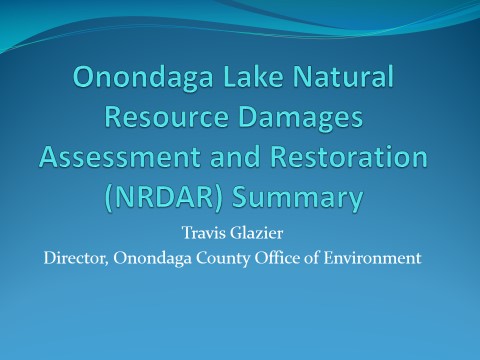
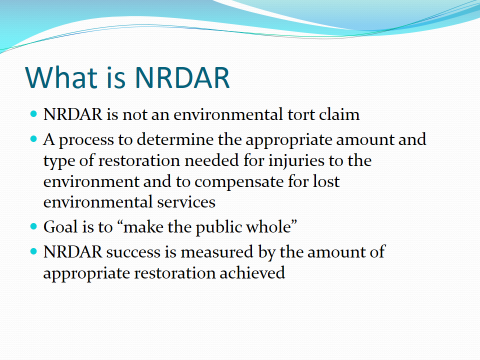
 
-
Important caveat – resources do not have be used on Onondaga Lake, the Onondaga Lake Superfund Site, in Onondaga County or even NYS; e.g. migratory bird makes stop-off in Onondaga Lake, trustees identify service created by those birds was rendered during time of public loss, to make public whole need to improve lives of migratory bird, however migratory bird process begins in Wichita, trustee can propose project in Wichita to make the public whole; very abstract concept; NYS Attorney General’s office legal counsel for NYSDEC, Department of Interior represents US Fish and Wildlife Service; trustees act on behalf of the public of the United States not Onondaga County - items relative to the County may not be relative to the US public that trustees are representing
- Release is the contamination; Onondaga Lake Superfund Site currently between planning and construction stages

Chair Plochocki said that the aspect of the NRDAR process being discussed is not the cleanup of the lake, per se. The NRD process pertains to a particular federal law that says when something is polluted, and you are in the process of cleaning it up, one must make an assessment of how much ecological and recreational loss was done and there must be damages to compensate the public - this is a damages discussion, not a cleanup discussion. In terms of these losses, the date 1980 is very important because this is when CERCLA came into being – CERCLA being the federal law behind this. Hypothetically he questioned if a body of water was already highly polluted in 1980, are the ecological and recreational losses being measured from 1980, with that as a baseline, or do they look at the lake as pristine from 1980 onwards - asked if he was getting ahead of himself, and if there was a quick answer. Mr. Glazier said that the assessment itself sets the baseline, which is part of the document to be released; those facts will be explained in greater detail in the RP/EA.
Mr. Murphy said there was no short answer. CERCLA also addresses releases that took place prior to 1980, as the law was enacted because they realized there were hazardous waste sites across the country and they needed a way to clean them up. There may be other sorts of differences. If you go back in history, at this point in time, the level of water in Onondaga Lake is controlled by a dam on the Seneca River, which changed the environment of the lake - that sort of change would not get measured in all of this. This is focused on what happened because a hazardous substance was released into the environment. Certain industrial processes caused discharges of mercury into the lake. One would expect trustees to look at the impact of mercury on the environment, fish, and how people used the lake because there were fish advisories due to mercury in the fish. Chair Plochocki asked if it was fair to say that if there was a discharge in 1960 into a hypothetical lake, and there wasn’t any discharge after that, it could still be looked at when measuring damages in 1982. Mr. Murphy responded, generally speaking, yes.
Mr. Glazier said that in this particular case the contaminants of concern are mercury and PCB’s – PCB’s are measured in the fatty content of the fish and mercury is measured in the blood. The impacts of the release are able to be measured through the ecological effects of the release itself. The next couple of slides cover exactly what the differences are between these injuries, or making the public whole, and an actual cleanup.

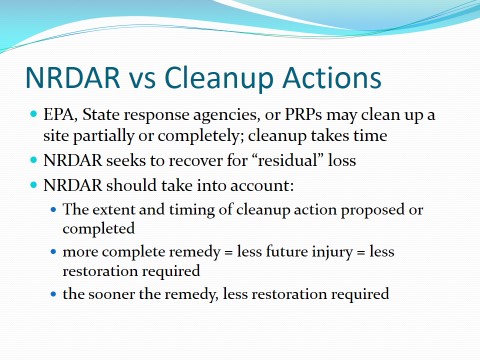
-
Discussion is delta of A, important to note this body has historically looked at Remedial Investigations/Feasibility Studies (RIFS) - lays out series of criteria and potential cleanup options with estimated dollars; in this case trustees don’t care about costs, only care about the value of A; must focus on what the value would be for the time period in which the release took place and how the trustees intent to make the public whole
In answer to Chair Plochocki, Mr. Glazier confirmed that the beginning of the red line represents the start of the contamination, not 1980. Mr. Glazier said that the point in which that happened is a moveable thing. The point at which they began to evaluate the impact is really what matters.
- Residual loss equals A; additional loss during time of cleanup to completion also compensated for


-
Cleanups may not eliminate all harm or future losses, i.e. bearer wall around southwestern shore of Onondaga Lake serves to prevent further contamination but does not have an ecological benefit, simply keeping contamination on one side, acting as remedial way to protect human health - wastebeds and contaminants within them are contained and the ground water is managed; NRDAR looks at steps needed to make the public whole for losses associated with release into that area - mercury and PCB’s getting into the food chain
- Draft RP/EA and notification of public meetings will be sent to the committee, had hoped to discuss but must adhere to trustees timeline
 
Mrs. Tassone asked how long the process would take. Mr. Glazier said that the process has been going on for a long time. Mr. Murphy said that the process started 15 to 20 years ago, but was put on hold while they were dealing with other issues. It has been reactivated and very active for the last 6 or 7 years - evaluating and calculating what that loss is. Mrs. Tassone said that this could go on for years and years. Mr. Murphy said in theory yes, but in practice they think less than 10 years maximum. Mr. Glazier said that over the last 6-7 years trustees took in 100+ different project concepts from the community for restoration projects and have reviewed them. Some may be part of the RP/EA to be released, which will have specific information on the individual projects. This has been a very open and public process, although because of the complexity a small set of people understood how to pursue this potential funding.
Mr. Burtis questioned if there was an end in sight, or was it when the trustees feel they have reached the goal of making the public whole. Mr. Glazier said that they would put out the RP/EA with the list of projects and take comments. Assuming they are able to answer the public comments, and move forward with the projects within it, they would then begin those projects as the restorative process for making the public whole. It would then advance to the construction phase of the chart, meaning that they would be at the beginning of the end. Construction could take 2 to 5 years and beyond. There are expectations that the restorative projects have ecological impacts that make the public whole. This would be ongoing – by no means is this a conclusion to the process. It is simply beginning the actual action, which will deem to make the public whole. The point at which the public is made whole is date uncertain – could be a very long time. Mr. Burtis said that this could be very fluid – could find more things, or things could get better. Mr. Glazier agreed, adding that some things may not work as intended and the trustee will then revise the project, and change direction, to make the public whole. Mr. Yaus agreed that things could change, but per the calculations it is intended that completion of the projects will make the public whole and be the end. Mr. Glazier said that these projects will involve monitoring and some amount of reporting as to their effectiveness on the intent of making the public whole.
- On site projects could be tremendous benefit, great opportunity for public to re-engage with this area and gain benefits lost over this period of time - excited about potential
A motion to adjourn was made by Dr. Chase, seconded by Mr. Burtis. Passed unanimously; meeting adjourned at 10:01 a.m.
Respectfully submitted,

KATHERINE M. FRENCH, Deputy Clerk
Onondaga County Legislature
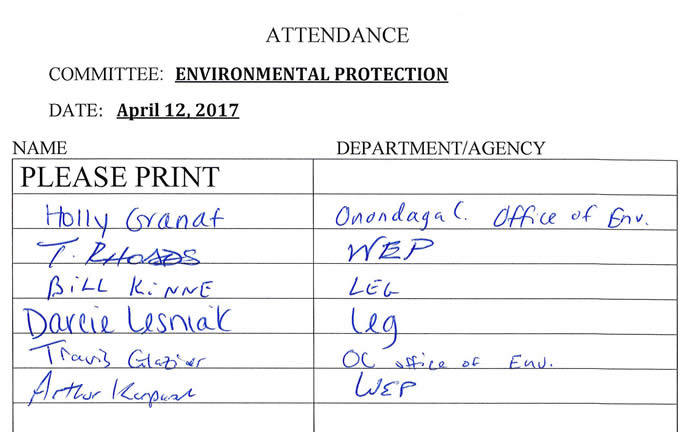
.
* * *
.
COUNTY FACILITIES COMMITTEE MINUTES – APRIL 12, 2017
JUDITH A. TASSONE, CHAIR
MEMBERS PRESENT: Ms. Cody, Mr. Plochocki, Dr. Chase
MEMBERS ABSENT: Mr. Dougherty
ALSO ATTENDING: see attached list
Chair Tassone called the meeting to order at 10:37 a.m. A motion was made by Dr. Chase, seconded by Mr. Plochocki to waive the reading and approve the minutes of the previous committee meeting; MOTION CARRIED.
1. CNY ARTS: Stephen Butler, Executive Director
a. Amending the 2017 County Budget to Make Funds Available to CNY Arts for Distribution to Musical Associates of Central New York, Inc. ($62,500)
Chair Tassone stated Mr. Butler will explain everything to the committee and come back next month. The committee cannot vote on this item, because what is on the agenda is totally different from what he wants.
Mr. Butler:
-
Usually come here for funds for Symphoria; Legislature asked CNY Arts to come in for contingency funds for economic development, but it was put on the agenda as Symphoria
-
Each year funds set aside for economic development for arts and culture community; put together panel of experts and people without conflicts of interest to evaluate applications; then come up with awards
-
Project goal to generate economic development; have to be exciting enough to pull people in from outside of County
-
i.e. – Symphoria working with Landmark to do video games concert; done years ago; this is new version; wide reach; lots of young people there who cheered for Symphoria; Symphoria will do most of their own marketing
-
Everson repositioning itself to pull stored ceramics to permanent collection; re-launch as premier ceramics collection in the country
-
Each project estimates number of guests coming from within and outside of County
-
Totals $125,000; projects in fiscal year, will ask for all money; May to December goes quick
.
Chair Tassone asked if there were a lot of applicants, and Mr. Butler responded yes. CNY Arts asks the applicants to write a letter of inquiry, and there were 9. The letters are then sent to the panelists. There has to be at least two interested in the project, otherwise the project is not invited to be forwarded; 7 chosen. Those that do not make it are provided with comments, and the hope is they will come back next year. Some have come back multiple times before being funded. Chair Tassone asked if Mr. Butler plans on continuing this year after year, and Mr. Butler said yes. As long as the Legislature is pleased with the program, and the program does what it is intended to do, then yes.
Mr. Butler apologized again for the confusion.
2. TRANSPORTATION: Marty Voss, Commissioner
a. A Resolution Authorizing the Reconstruction and Construction of Improvements to Various Highways in and for the County of Onondaga, New York, at a Maximum Estimated Cost of $4,600,000, and Authorizing the Issuance of $4,600,000 Bonds of Said County to Pay Costs Thereof ($4,600,000)
.
-
Bonding for 2017 Highway Work Plan; $4.6 million helps leverage $25,652,000 worth of work; local share leverages state and federal participation; 85% federal, 10% state, 5% local
-
Work plan – maintain database of pavement ratings, which determines baseline for what to do; staff and consultants drive the roads and keep informal list
-
Work to put plan together after budget, balance what can do; maximize money with need; relatively regionally balanced; worst to first; product on road – cold mix is less than 4,000 cars driven daily, anything greater than 4,000 is hot mix
Chair Tassone asked if there was a copy of the highway plan for members. Mr. Voss responded that he gave one to Mr. Knapp, Chair Tassone, and the Clerk. Chair Tassone stated the members need to have one; Mr. Voss said that he gave a copy to the clerk to distribute. Chair Tassone said it is easier to talk about it when they have the plan. Mr. Voss stated the resolution is just to support the bonds. Mrs. Stanczyk asked if the only copy of the plan was on the table, and that the Clerk did not receive the plan electronically; Mr. Voss agreed. Mrs. Maturo stated that she does not have copies, the document was not filed with her nor were copies provided for members. A draft copy was provided for Chairman McMahon via Legislator Knapp.
Chair Tassone asked what the final number is that the state is giving the County. Mr. Voss responded to Chair Tassone that CHIPS is $5,638,378.43.
Chair Tassone commented that item a is for the bonding, which is done every time this comes up. It is to keep up with the roads; 98% of roads are favorable in Onondaga County. Mr. Voss interjected that a lot of this is pavement preservation, which the department uses to try to extend the life of the roads. Before the roads are deteriorated, Transportation tries to maintain them, so as to limit the larger expense of rebuilding roads.
A motion was made by Dr. Chase, seconded by Ms. Cody, to approve this item. Passed unanimously; MOTION CARRIED.
b. Amending the 2017 Onondaga County Budget to Make Funds Available for use in Connection with the New York State Pave-NY Program, and Authorizing the Execution of Agreements ($1,288,191)
-
Newer program; no numbers yet; budget extender state passed last week of March included transportation capital projects; no list yet, but will go back through; first batch will be worst of worst
-
Second year of this; great thing state is doing to support local infrastructure; anything Legislators can do to advocate to keep the state funding this program would be beneficial
Mr. Voss responded to Chair Tassone that the department will look at the dollar amount they are receiving, and divide it by the projected costs. They will try to get in as many as they can in this construction season.
Dr. Chase wanted clarification that there is no specific plan, but they know the amount of money. Chair Tassone said it is the opposite. The County just found out what the money will be when the budget passed, and Chair Tassone is sure Transportation has projects lined up. Mr. Voss commented that they will get a list together.
A motion was made by Ms. Cody, seconded by Dr. Chase, to approve this item. Passed unanimously; MOTION CARRIED.
c. Amending the 2017 County Budget to Make Funds Available for use in Connection with the Reconstruction and Construction of Improvements to Various Bridges within Onondaga County
-
Not asking for bridge bond this year; using cash out of Onondaga Tobacco Asset Securitization Corporation proceeds
-
Spending $880,000 cash this year to do bridge work; of $3.5 million, this resolution shows where everything is going for 2016, 2017 and 2018
-
Appropriate $880,000 for bridge projects this year; $1.6 million for lake trail extension (Lakeview Amphitheater to Hiawatha Boulevard), in engineering process; also use smaller pieces to cover local share on federal aid bridge projects
.
Dr. Chase asked if they have the money, and Mr. Voss replied yes. Chair Tassone stated there is $3.5 million total in the Onondaga Tobacco Asset (OTASC).
A motion was made by Dr. Chase, seconded by Mr. Plochocki, to approve this item. Passed unanimously; MOTION CARRIED.
.
d. Amending the 2017 Onondaga County Budget to Accept Funds from New York State’s State and Municipal Facilities Program to Provide Improvements at the Lakeview Park & Amphitheater, and Authorizing the Execution of Agreements ($500,000)
-
Accepting $500,000 grant through Dormitory Authority of State of New York; secured by Assemblyman William Magnarelli for purposes of improving guest experiences at Lakeview Amphitheater
-
Conduit for grant; under State Municipal Facilities Program; use term services contractor to pave back of house areas where performers and vendors are parking; also walkways that connect orange lot to Amphitheater
-
Objective to maximize value of grant; get as much of the dirt paths covered before concert season in June
-
If all goes well, hope to mobilize getting this done before Memorial Day; have paved and not have dust
.
Chair Tassone said dust was the main concern.
Mr. Voss:
- Strategically laid out; doing in house with own staff; getting biggest bang for buck
-
Not all asphalt; commercial areas will be oil and stone to handle trucks and buses for those that have to get around to back of amphitheater; tour buses and employees
-
Focusing on walkways for people, strollers and handicap accessibility (driving force); Assemblyman Magnarelli required County to make ADA compliant
-
State DOT and NYS Fair will be paving 125 space ADA lot in corner of orange lot, nearest box office; ADA parking available for those in wheelchairs, then they will take paved pathway to Amphitheater seats
.
Dr. Chase asked if DOT is working with WEP to make this a green project. Mr. Voss responded yes. There are bioswales put in to catch the water in the impervious surfaces. Travis Glazier is working with DOT on the overall site plan, and WEP is involved as well. The objective is to get this where it needs to be with not only ADA compliancy, but also making it an attractive venue (no dust or mud).
Mr. Plochocki stated for the record that the County is accepting state funds for this. There is zero County budget impact. The County is receiving money from the state as secured. Mr. Voss said yes, and clarified that it is a reimbursement program. Mr. Plochocki wants this to be 100% clear, because there are concerns amongst taxpayers about how much more local money is being put into the Amphitheater. Mr. Voss stated if there was not a state grant, the work would not be able to be done this year. The reason it is being done is because Assemblyman Magnarelli was able to secure this State and Municipal Facilities Assistance Grant for the County.
A motion was made by Mr. Plochocki, seconded by Dr. Chase, to approve this item. Passed unanimously; MOTION CARRIED.
Chair Tassone asked Mr. Voss to go over the Highway Work Plan (next page). Mr. Voss asked if they would like to go over the funding or the projects, and Chair Tassone said to discuss the projects.
Mr. Voss read through the projects from the work plan on pages 4 – 9, including clarification on the term bituminous. Bituminous is a surface treatment DOT will put over certain roads (preservation). Everything in the plan for cold mix will also get bituminous to preserve it. Chair Tassone asked what the life span is. Mr. Voss responded that the bituminous should add 5 – 10 years. If there are things that can be prevented, it is more advantageous then spending the money to rebuild an entire road.
Mr. Voss read through the cold mix projects on page 13 (map on page 14), and the hot mix projects on page 15 (map on page 16).
Mr. Plochocki asked if these projects will be done in 2017, and Mr. Voss responded yes.
Mr. Voss explained that bituminous covers three things: oil and stone, skinny treatment or novachip. It is preventative maintenance. These capture what is on the cold mix list plus more. Mr. Voss read through the bituminous projects on page 17 (map on page 18).
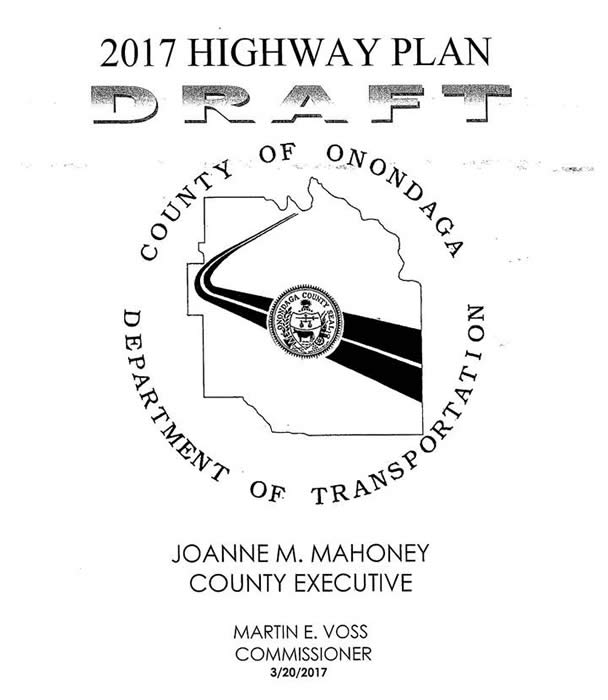
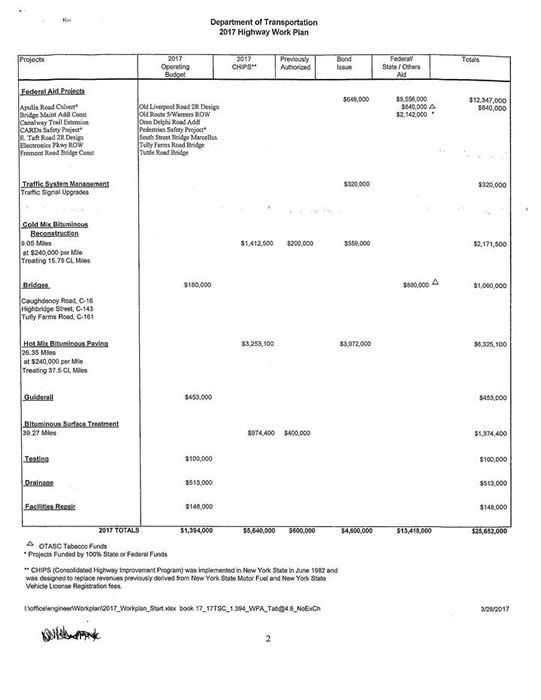
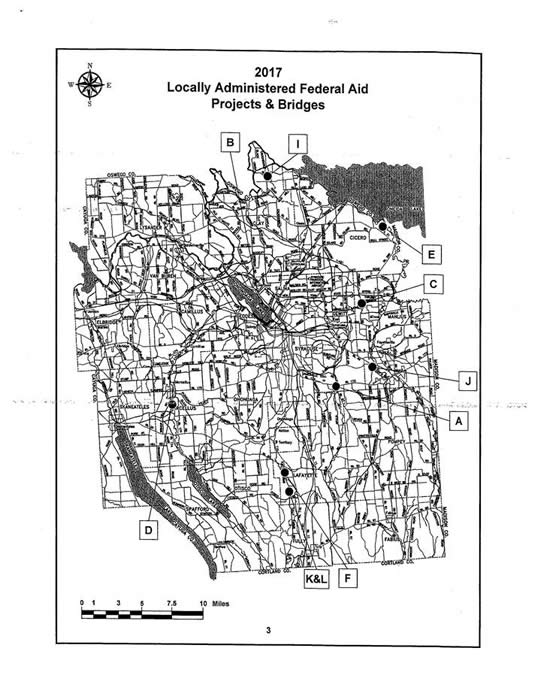
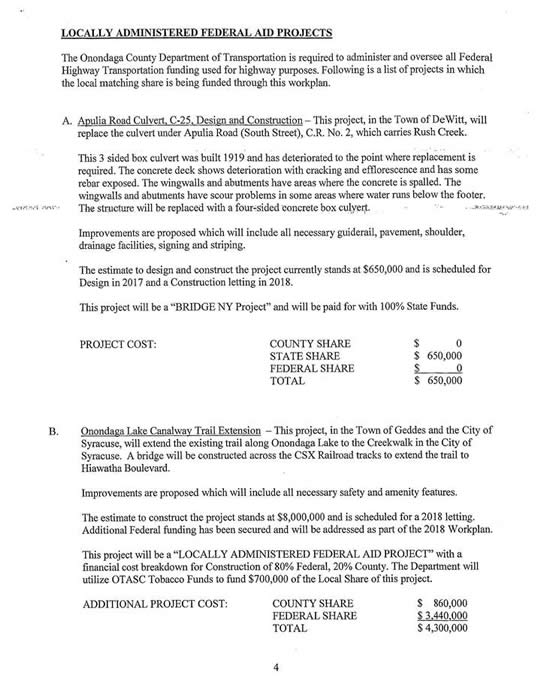
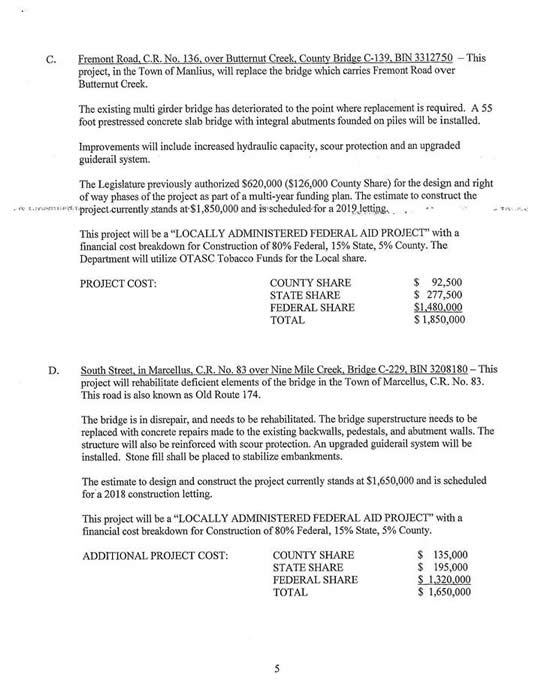
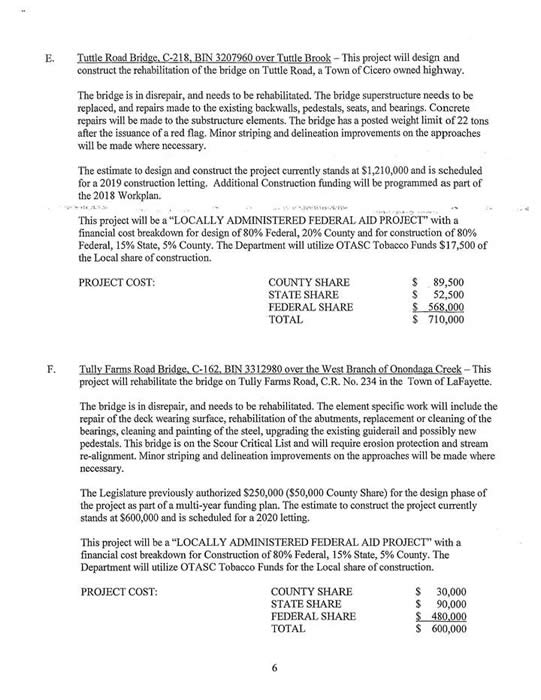
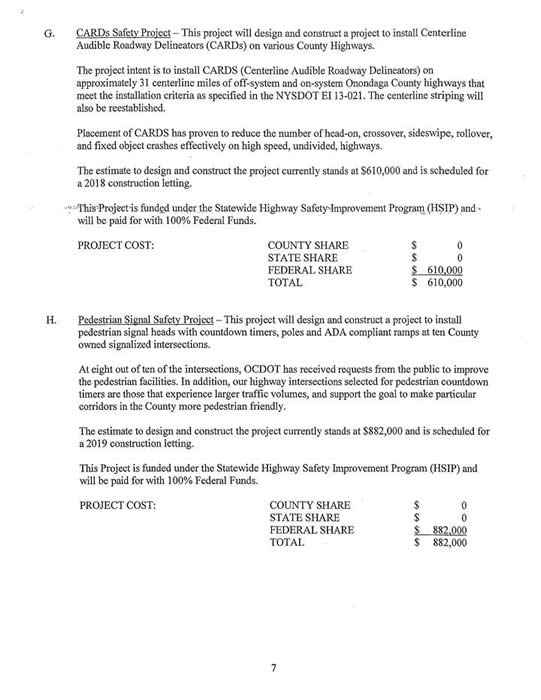
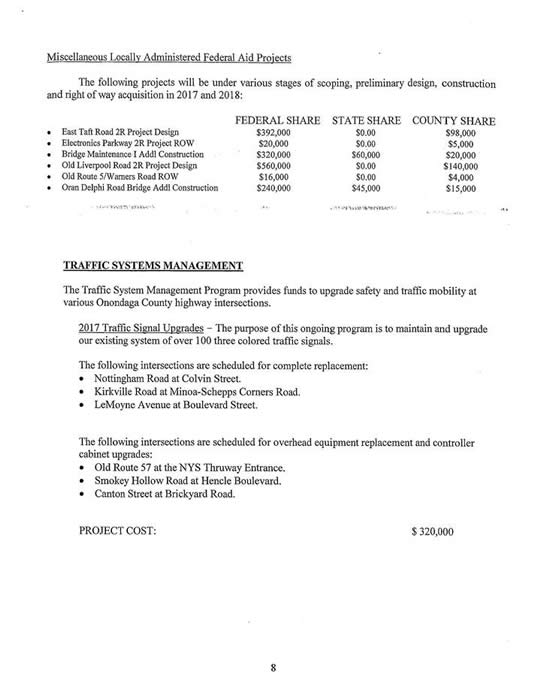
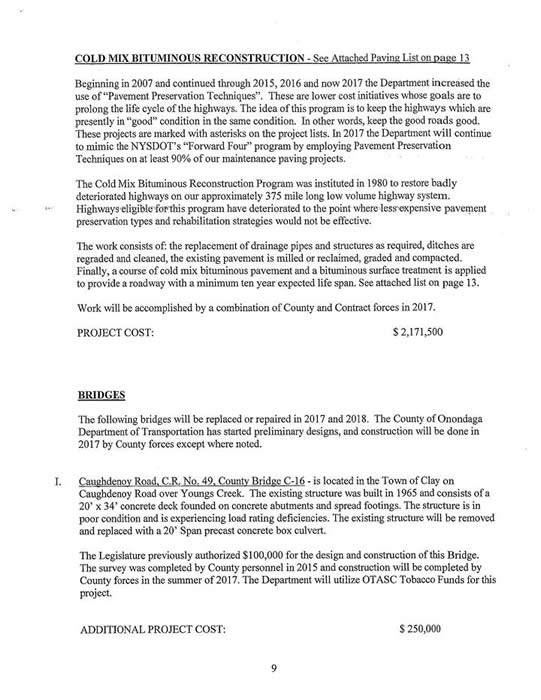
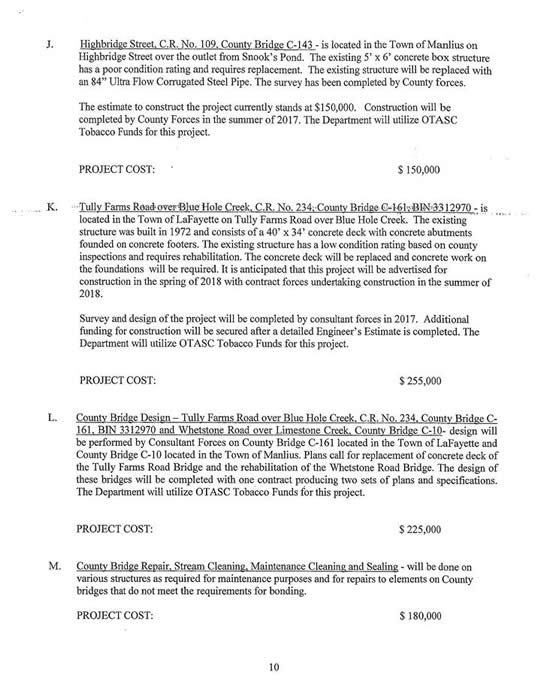
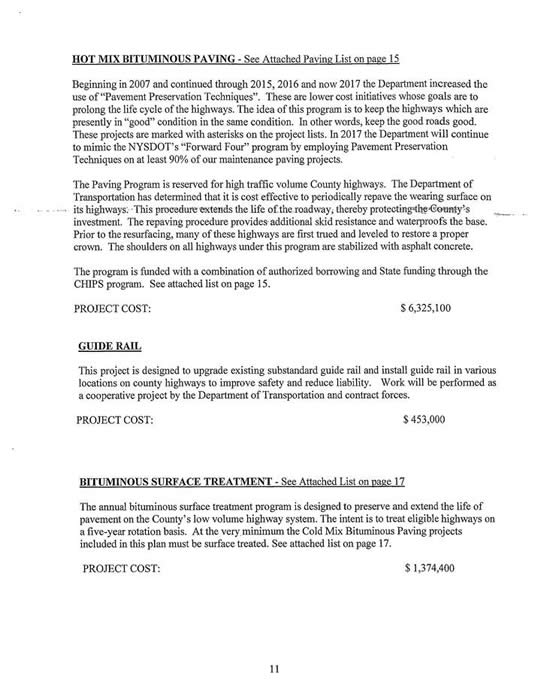
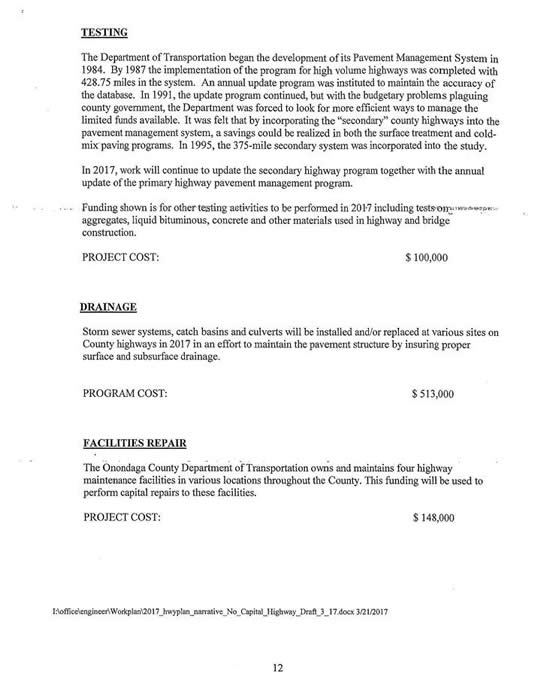
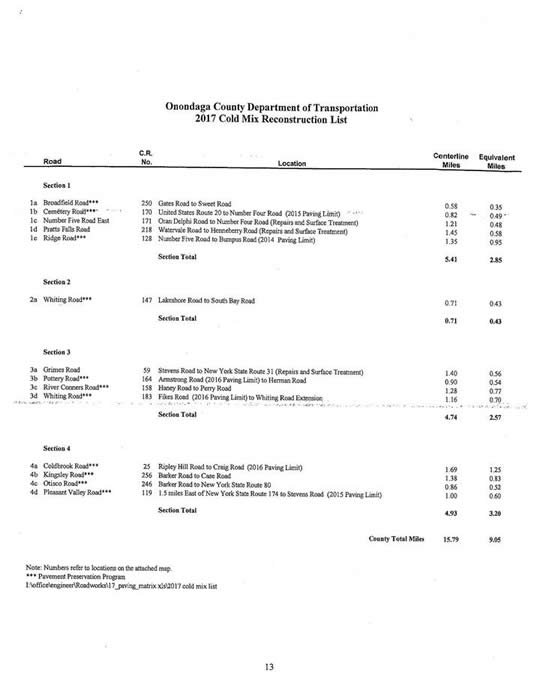
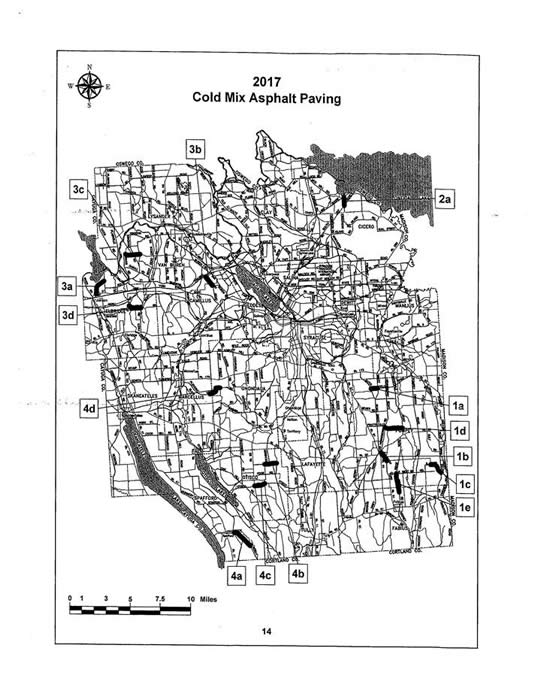
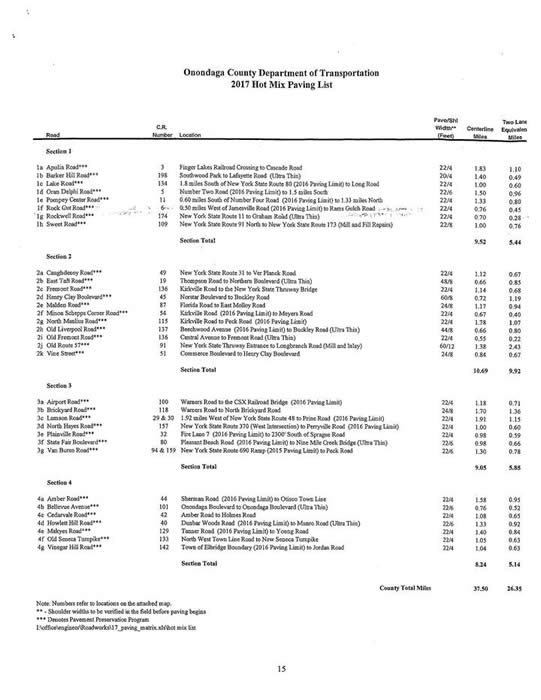
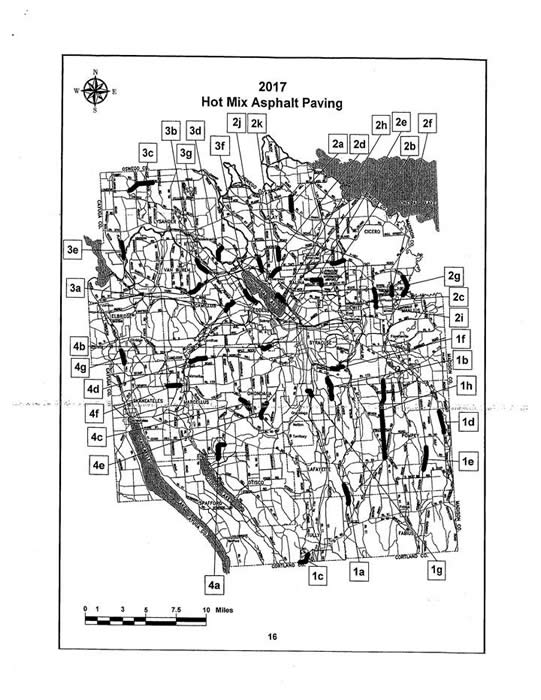
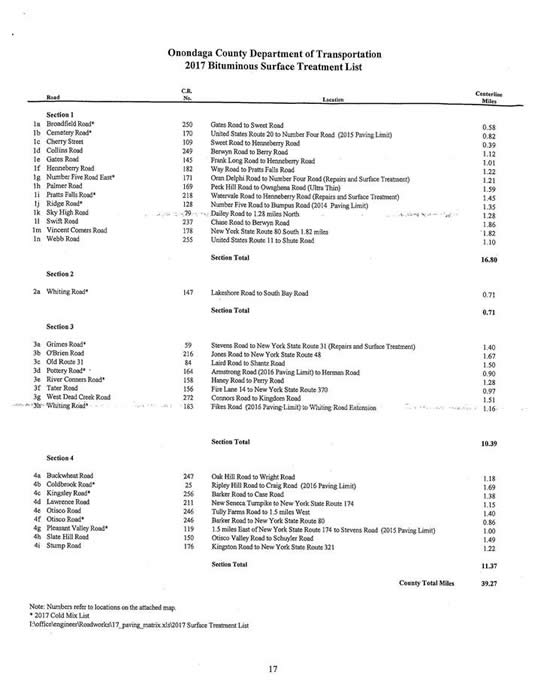
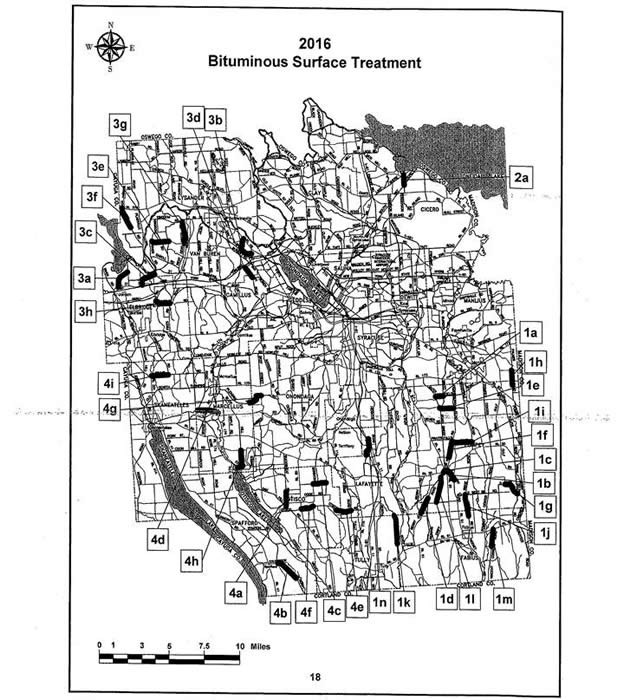
The meeting was adjourned at 11:15 a.m.
Respectfully submitted,

JAMIE McNAMARA, Assistant Clerk
Onondaga County Legislature
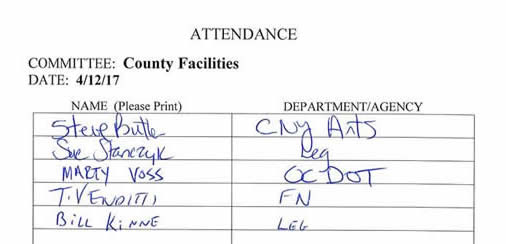
.
* * *
PUBLIC SAFETY COMMITTEE MINUTES – APRIL 12, 2017
BRIAN MAY, CHAIRMAN
MEMBERS PRESENT: Mr. Holmquist, Mr. Ryan
MEMBERS ABSENT: Mr. Liedka, Mr. Dougherty
ALSO ATTENDING: Mr. Knapp and see attached list
Chair May called the meeting to order at 12:04 p.m., and noted that some items would not be voted today. They are works in progress but warrant discussion.
A motion was made by Mr. Holmquist, seconded by Mr. Ryan, to waive the reading of the proceedings from the previous committee. MOTION CARRIED. A motion was made by Mr. Ryan, seconded by Mr. Holmquist, to approve the minutes from the previous committee. MOTION CARRIED.
1. JUSTICE OVERSIGHT COMMITTEE: Ann Rooney, Deputy County Executive/Human Services
a. Confirming Reappointment to the Onondaga County Justice Center Oversight Committee (Robert Slivinski)
Ms. Rooney:
- Committee formed 1.5 years ago with staggered appointments; great member, deputy chair
A motion was made by Mr. Holmquist, seconded by Mr. Ryan, to approve this item. Passed unanimously; MOTION CARRIED.
2. SHERIFF: Paula Pellizzari, Captain, Police Dept.
a. Amending the 2017 County Budget to Accept Drug Enforcement Administration Funds for Cannabis Eradication Work Performed by the Air One Program of the Onondaga County Sheriff’s Office, and Authorizing the Execution of Agreements ($15,000)
Captain Pellizzari:
- Received funds past several years, will use to offset Air 1 fuel costs
A motion was made by Mr. Ryan, seconded by Mr. Holmquist, to approve this item. Passed unanimously; MOTION CARRIED.
b. Transfer from Sheriff’s Office, Account 666500 Contingency, to Sheriff’s Office, Account 693000 Supplies & Materials, $500,000
- Request release of contingency funds, or portion of, for supplies
Chair May said there may have been some confusion at the last meeting with regard to releasing all the contingency. Through the budget process they have taken a measured approach and got rid of the extra items, which had been in contingency, mainly as a result of the Sheriff department’s excellent stewardship of the funds within their budget. After discussing with Finance, $300,000 is enough for their immediate needs, and allows the department to come back with an update later in the year.
A motion was made by Chair May to amend the dollar amount from $500,000 to $300,000.
Chair May said that the funds are for routine jail supplies. Captain Pellizzari said that they are supplies as whole for the entire Sheriff’s department. Some of the documents included examples, much of which has been spent on inmate supplies thus far this year.
Mr. Ryan asked what would be cut if the amount was reduced. Captain Pellizzari replied when ready, later in the year, they would come back and request the balance.
Mr. Ryan asked when the last release was made. Chair May said that it was whenever they exhausted what was left in the contingency last year. Mr. Ryan said that it would have been yearend and they didn’t go over budget. Chair May confirmed he was correct; ended year $260,000+ under budget.
In answer to Mr. Ryan, Chair May said that $500,000 had been put into contingency for supplies - was not everything, just part. Mr. Ryan said that if the amount was amended the rest would remain in contingency for them to come back at some point. Captain Pellizzari agreed. Chair May said that it is simply an excuse to look at the projections and talk about how things are going. The process is working great – 2 in a row for Sheriff Conway, at or below budget, and the last budget, prior to him coming on, was a balanced as well. This was a function of the legislature’s doing as much was put into contingency. And now it is just supplies and overtime, 2 things they must ensure they continue to talk about.
Mr. Ryan said that they accomplished what they wanted to do. They put things into contingency to provide more oversight, which for the record, was greatly needed. Chair May replied, “Way back when”. Mr. Ryan said that they have righted that ship and he does not want to hinder the operation if these funds are needed. Captain Pellizzari reiterated that if the entire $500,000 is not released now, they will come back when needed, based on projections - meets with financial operations weekly and is on top of the projections. Chair May said that in the spirit of doing this right, he contacted Management and Budget to find a comfortable number for release. It is not something that will constrain the department.
Mr. Ryan asked that a comparison of last year to this year be provided when returning to request the remaining funds. Captain Pellizzari replied that it would not be a problem.
Mr. Holmquist noted it is amazing how smoothly things can go when there is outstanding communication, in this case, between the Sheriff’s department and County Legislature. Meetings are shorter, everyone is in agreement and on the same page; great model for the rest of the County. Chair May agreed.
Seconded by Mr. Holmquist. Passed unanimously; MOTION CARRIED.
A motion was made by Mr. Ryan, seconded by Mr. Holmquist to approve this item as amended. Passed unanimously; MOTION CARRIED.
3. Animal Abuse Registry Local Law (Sponsored by Mr. Liedka, Mr. May, Mrs. Tassone, Mr. Knapp)
Chair May:
-
Item for the purpose of discussion – resolution submitted to Law, provides a place for animal owners selling pets to vet purchaser to ensure they are not an animal abuser
-
Great job by Ms. Lesniak assembling information from other counties, Law providing necessities and appropriateness for what is included within the registry and thresholds for inclusion – items being worked out in fine detail
-
Sheriff announced this will happen at no cost to taxpayer
-
Legislator Liedka behind this 110%, apologized for being unable to attend
Chair May asked if Ms. Berger had anything further to add. Ms. Berger replied that she would speak with sponsors on an attorney client bases, if they so desired.
Mr. Ryan asked whom they would be registering with. Chair May replied that as proposed it would be Onondaga County’s own registry. To be clear, this is a work in progress, an update on the initiative. He does not envision this being something that will be voted on right away. It is something the committee needs to be formally aware of and will proceed from here.
Mr. Holmquist said that the committee agrees with the spirit of the law. Chair May said that it was a great idea. They are not creating laws to be enforced, but are using an opportunity to leverage what is taking place to better inform the public, if they are able to do this. The if word cannot be ignored – it is a work in progress.
In answer to Mr. Ryan, Chair May said that the registry would maintained by the Sheriff’s department, and there was much enthusiasm from the animal rights agencies.
4. ASSIGNED COUNSEL: Kathleen Dougherty, Executive Director; James Murphy, ACJ Board
a. Amending the 2017 County Budget to Make Funds Available for use by the Onondaga County Assigned Counsel Program ($4,284,821)
Ms. Dougherty:
- Request acceptance of funds provided last year as part of the Hurrell-Harring Settlement - $4.2 million authorized for caseload relief
Chair May asked if Judge Murphy had anything to add. Judge Murphy replied he was present to answer questions. Hurrell-Harring has been a confusing topic for the last year and a half, and depending on what is in the state budget, may or may not be less confusing. Chair May said that some, by virtue of their roles in the Legislature, have been closer to this situation than others. A meeting a few weeks ago helped them get a better understanding of exactly where things stood.
Chair May said that this money is here, but it is not going anywhere. This is one of the items that he would like to just discuss. The methodology of acceptance, and the uncertainty of what is in the state budget and how it will work, makes him really reluctant to just throw these funds into the project account and see where it goes. He wants to understand what’s going on, speaking from his personal prospective, based on his involvement thus far. There is much uncertainty as to how this will shakeout within the budget, and some uncertainty as to how these funds can be used. That question deserves to be discussed with the judge or someone who can help them understand how the dollars can be used. The general consensus is that it is all for indigent defense, but he does not see that in stone anywhere. If these dollars can only be used for indigent defense, the County needs a plan to address the implications of the settlement and how to arraign defendants going forward. The settlement of this case created an expense mandate being felt by towns, villages, jails, the DA’s office and courts at the County and local level. There is much to figure out.
Judge Murphy:
Ms. Dougherty:
-
County already accepted first 2 portions and the budget funding for last year - $2.5 million for counsel at arraignment and $855,000 for quality improvements, state and County entered into spending plan for those monies approved by the NYS Budget office and County, based on approval a contract was issued and funding started
-
3rd piece is caseload relief funds – expected funding to be appropriated by the state, put plan in place, County and state enter into contract to determine how the funding would be expended, delayed due to RFP process, great number of hours spent negotiating plan with the state, do not have approval yet as state budget was finalized Monday
Chair May asked if they were specifically talking about centralized arraignment. Ms. Dougherty responded no. Judge Murphy said central arraignment was a side bar. Chair May asked what the plan is for. Ms. Dougherty responded that it is for caseload relief – a very broad term. Primarily funding is there to allow for other non-attorney support services, i.e. investigators, interpreters, expert testimony. Caseload relief refers to a cap on the number of cases an attorney can handle so that they can do more on each case. In answer to Mr. Ryan, Judge Murphy confirmed that this is all part of the settlement. Chair May said that it is effectively quality defense.
Ms. Dougherty:
Judge Murphy:
- Uncertainty because of new program and new money
-
Ms. Dougherty talking with Indigent Legal Services (ILS), making argument that whatever ACP approves goes toward caseload relief; recently received categorization, one item is staffing – ILS agreed adding staff to ACP panel helps lawyers with administrative items and processes vouchers quicker
- Centralized arraignment secondary argument – goes along same lines, need statewide approval to use these funds that way
Ms. Dougherty:
- Funding for counsel at arraignment has been approved; each item must have its own separate plan
-
Emergency plan was on-call arraignment; assuming Sheriff and OCA funding can be resolved, counsel at arraignment funds would go towards attorneys at Centralized Arraignment Court rather than current off-hours, plan would change
Judge Murphy:
- Want to use portion of $2.5 million awarded for counsel at arraignment for centralized arraignment, more efficient, less costly; future argument has to be made
Ms. Dougherty:
- ILS agrees with centralized arraignment
-
Newly adopted state budget almost irrelevant to this caseload relief money, funds were made available last year, sitting in state coffers, obligated to provide the funds, on us to accept and have plan to spend it
Judge Murphy:
- RFP issued, will be back in next few months to accept 2017 funding
Ms. Dougherty said that there are a lot of moving parts and apologized for the confusion. Chair May said that it was a dynamic issue. There is so much to it, its mind boggling. Judge Murphy said that to pay magistrates for centralized arraignment is approximately $95,000 per year, in Onondaga County. They believe this money is in the judiciary budget, but have not seen the approved state budget for confirmation. Once confirmed, they can move forward on the remaining issue of transport.
Chair May said that the information was incredibly helpful on both sides of the equation. He still does not want to vote today, but the intent is not to delay. The item has been discussed and can be voted on at Ways and Means and the May session. They have not had the benefit of the other 14 legislators discussing this issue in their respective caucuses and, in his opinion, they must get their heads around the overall implications of this as a group. Some may be a little ahead of the curve, while others need to catch up.
Mr. Ryan said that he was not a member of Ways and Means and would like to see this voted on and appropriated. This is basically part of a lawsuit and the County must be in compliance. There are people in need of these services, and certain people and groups did not think they were receiving the services they were entitled to, hence litigation. Chair May replied that he talked to Chairman McMahon about process and feels they need to get everyone up to speed.
Judge Murphy said that they were happy to attend either caucus, as they know this is confusing. Chair May said that it was a matter of getting a handle on their overall approach. Delaying acceptance is not the intent, it is to get a few more people on board. Public Safety Committee members have a slight advantage on some of this. However, going forward, it will require legislative action to ensure they are doing everything they are supposed to be doing, including properly funding.
No action was taken on this item.
5. HILLBROOK: Damian Pratt, Director Juvenile Justice and Detention Services; Ann Rooney, Deputy County Executive/Human Services
a. A Resolution Authorizing Improvements at Hillbrook Detention Facility, in and for the County of Onondaga, New York, at a Maximum Estimated Cost of $394,000 and Authorizing the Issuance of $394,000 Bonds of Said County to Pay Costs Thereof ($394,000)
Ms. Rooney introduced Damian Pratt as the Director of Juvenile Justice, in the Department of Children and Family Services, which does not typically present to Public Safety. Mr. Pratt has oversight of Hillbrook and will run through the project.
Mr. Pratt:
-
First significant improvement project at Hillbrook since 2006, covers cost of upkeep from safety standpoint - upgrading security system, cameras, control panel, 6 doors throughout facility, and emergency duress system worn by all personnel
- Keeps building up to standards with the Office of Children and Family Services regulations
In answer to Mr. Ryan, Mr. Pratt confirmed that much of this is mandated. Chair May said that, as per committee policy, they will have two bites - capital projects come in and then get voted on at the next committee meeting. This all makes sense, especially with state budget, which is not yet fully understood. However, they know there are implications for raising the age and will be more demands there.
Based on what they know at this time, Chair May asked that they talk about raising the age and what they envision the challenges to be for Hillbrook.
Mr. Pratt:
-
Still early, trying to figure their way, want to carefully evaluate many possible strategies – must consider how to house population coming from Justice Center, may need to keep 16 and 17 year olds separate from 12 and 13 year old population
-
Forced to reevaluate non-secure detention contract and Hillbrook’s regional role with surrounding counties - currently utilized as detention facility for under-16 population, could be expanding shortly; will evolve much over next 18-24 months
Ms. Rooney:
-
Currently never full, have 4 8-bed pods with 3 pods typically open; approximately 30 youth aged 16 & 17 currently housed at the Justice Center with various charges
-
Missed November committee in part due to 2013 reorganization – changed administrative code and charter, Hillbrook now under the Department of Children and Family Services, apologized wasn’t looking for Hillbrook items on Public Safety, anticipated capital item to be under Health; have discussed item with Legislator Liedka
-
Regularly speak with Sheriff about this, charges in Family Court differ from criminal system, may not mean individual would be demanded into detention, two different systems, believe state is proposing hybrid with Youth Court, i.e. based on charges and history of youth Criminal Court judge may transfer case to Family Court – doesn’t happen now, need to figure out how to institute hybrid model; not worried about capacity at Hillbrook, simply how to treat populations differently, if at all
In answer to Mr. Ryan, Ms. Rooney confirmed that cases transferred from Criminal Court to Youth Court would then be under the umbrella of OCFS, instead of NYSDOCS; for transfer much will depend on the severity of the charge. Mr. Ryan said that there are many moving parts to this, besides judge’s discretion, must also consider the DA’s charge.
Mr. Ryan said that females must be housed separate. Ms. Rooney replied that they never have 8 females. Mr. Pratt said that as of this morning they have 17 youth, the average is 15 and highest is 26, a one-week anomaly. Mr. Ryan said that going forward they are faced with most 16 and 17 year olds moving out of the Justice Center and going to Hillbrook. Ms. Rooney replied no, the Family Court system is very different than Criminal Court. Youth detained because they can’t make bail on the Criminal Court side will not be a factor on the juvenile justice side where community safety is the main factor and there is no bail. OCFS has already made overtures with the anticipation that this was going to happen. There is a strong likelihood that OCFS will have a regional facility, as smaller surrounding counties don’t’ have detention facilities.
Mr. Ryan said that youth received from other counties generates revenue to a certain extent, and he is hopeful that they look at this from a regional standpoint. He does not want to add more beds and a new wing, but they have to be cognizant about other counties wishing to use the facility. Ms. Rooney agreed, adding that they have been proactive with OCFS for the last couple of years.
Ms. Rooney:
For the record, Chair May said that this is and has been in the capital plan. Ms. Rooney said that this was not related to raise the age. Chair May said that he was aware of that, and asked if any of the improvements were eligible for grants. Ms. Rooney said that they receive their regular reimbursement rate from the state, but this in particular is not. Chair May said that this is just hard capital physical improvements. Ms. Rooney agreed.
Chair May said it bears mentioning that there is a savings to the cost of the number of youth housed at Hillbrook. It is undoubtable one of their most expensive operations. An upside to having youth in Family Court is their ability to remediate certain problems, which alleviates detention requirements. There is are upsides to this in many different ways, just have to see how it shakes out over time. Ms. Rooney said that unlike the Justice Center, which is all local dollars, they receive significant reimbursement from other counties, as well as the state, for detention. Mr. Ryan said that they would also save money in the future as recidivism rates would be reduced via the use of OCFS, youth programs, and education.
Chair May said that the item had been discussed and would be voted on at the next meeting.
Mr. Knapp apologized for arriving late and was brought up to speed on the previous discussion. Mr. Knapp said that this would also impact the Sheriff from a transportation standpoint. Ms. Rooney said that the Sheriff was going to have a party. Mr. Knapp said that perhaps they would have more information on the specifics of age limits by the time this goes to Ways and Means.
Mr. Ryan asked if they will be hearing more about age limits through Public Safety or Health. Chair May said that it has to be worked out. Ms. Rooney said that it is the only program in all of human services that falls under Public Safety; should have moved over with everything else. Hillbrook, Juvenile Justice, anything related to the Office of Children and Family Services, is all under the Health Committee. Chair May reiterated that legislative leadership and the County Executive will have to work this out.
No action was taken on this item.
6. Declaring Support for Enactment of Federal Legislation to Preserve Access to Air Medical Transport (Sponsored by Mr. Ryan)
Mr. Ryan:
-
Save Our Air Medical Resources (SOAR) national coalition working to pass federal legislation; bills haven’t been reintroduced to new Congress (former numbers H.R. 822 & S. 1149) seek to amend Social Security Act to increase Medicare/Medicaid reimbursement payments for EMS air transports – necessary care, cost increasing, current rates set in 1998; former legislation would have increased rates 20% in 2016 and 5% in 2017, 2018 and 2019
-
Air 1 files in Onondaga and surrounding rural counties, also have Mercy Flight - services greatly needed for county residence, increase helps to support longevity of services
- Supported by other counties and NYS Association of Chiefs of Police; not joining, just supporting SOAR coalition
Chair May said that Air 1 is not flying like it used to for medevac’s, but they don’t say know to needs. The demands on Air 1 for medevac, billing, and things such as this might even exceed the rationale behind the billing. What they are fighting for here is 20% of the cost of medevac’s at today’s costs. That is nothing compared to $1,200+ dollars per hour to run the ship. This makes sense as it helps anyone providing that service, out of necessity, to be slightly more reimbursed.
-
Also develops a system to collect data for operational costs, provides for independent government analysis of collected data, establishes ongoing reporting of industry consensus clinical quality measures and provides the increased reimbursement; data addresses how to run operation more efficiently
Chair May said that like any other health care service there will be a basis upon which the charges will be reimbursed; may not have existed previously. Mr. Ryan agreed adding that the data will address the reason for the need of additional funds, in his opinion.
A motion was made by Mr. Ryan, seconded by Mr. Holmquist, to approve this item. Passed unanimously; MOTION CARRIED.
The meeting adjourned at 12:54 p.m.
Respectfully submitted,

KATHERINE M. FRENCH, Deputy Clerk
Onondaga County Legislature
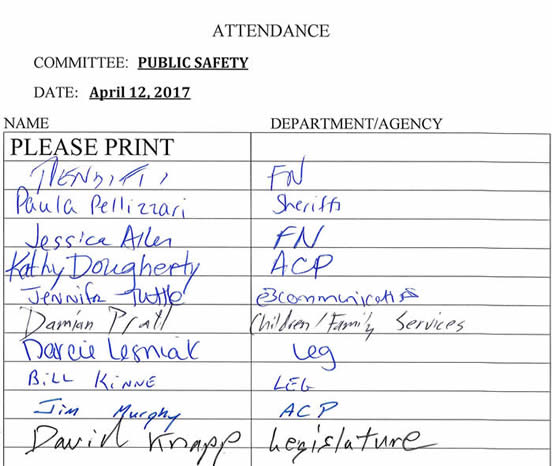
* * *
PLANNING & ECONOMIC DEVELOPMENT COMMITTEE MINUTES - APRIL 13, 2017
DEREK T. SHEPARD, JR., CHAIRMAN
MEMBERS PRESENT: Mr. Jordan, Mr. Knapp
MEMBERS ABSENT: Mr. Ryan, Mr. Plochocki
ALSO ATTENDING: See attached list
Chair Shepard called the meeting to order at 10:37 A.M. A motion was made by Mr. Knapp, seconded by Mr. Jordan, to waive the reading of the proceedings of the previous committee. MOTION CARRIED. A motion was made by Mr. Knapp, seconded by Mr. Jordan, to approve the minutes from the previous committee. MOTION CARRIED.
1. SYRACUSE/ONONDAGA COUNTY PLANNING BOARD: Don Jordan, Deputy Director
a. Calling for a Public Hearing on the Proposed Inclusion of Viable Agricultural Lands within Certified Agricultural Districts Pursuant to Section 303-B of the New York State Agriculture and Markets Law
Mr. Jordan:
- Open enrollment period Jan. 1-31, 6 property owners requesting addition of 14 parcels, 615 acres total to Districts 1,3 and 4
- Public hearing to be held prior to June Session; back next month for approval of additions with full report reviewed and approved by the Farmland Protection
- Large addition to District 4 – Lemondes farm
Mr. Knapp asked if there were deletions. Mr. Jordan replied that deletions can only occur during the 8-year review period for that district. Inclusions can be added each year during the January open enrollment period.
A motion was made by Mr. Knapp, seconded by Mr. Jordan, to approve this item. Passed unanimously; MOTION CARRIED.
2. VISIT SYRACUSE:
a. Tourism Update – David Holder, President
Mr. Holder presented the following:
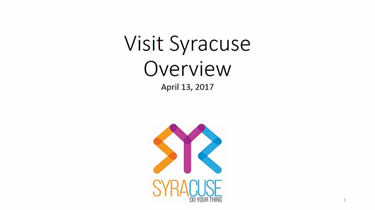
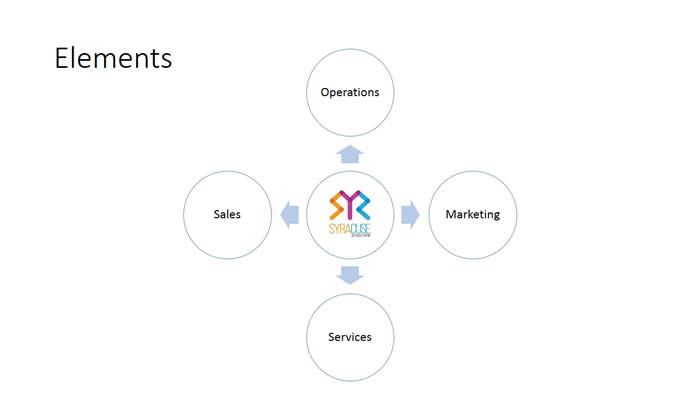
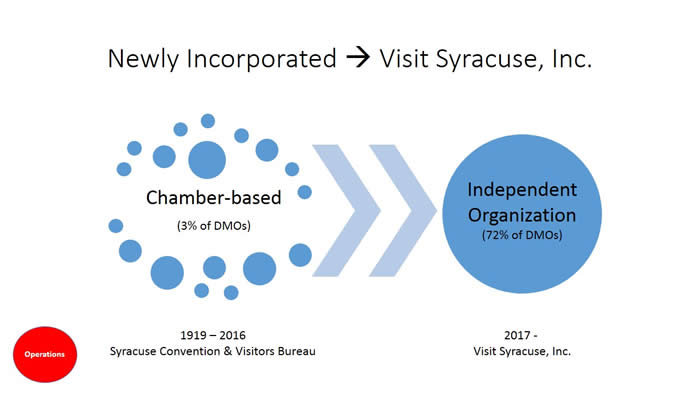
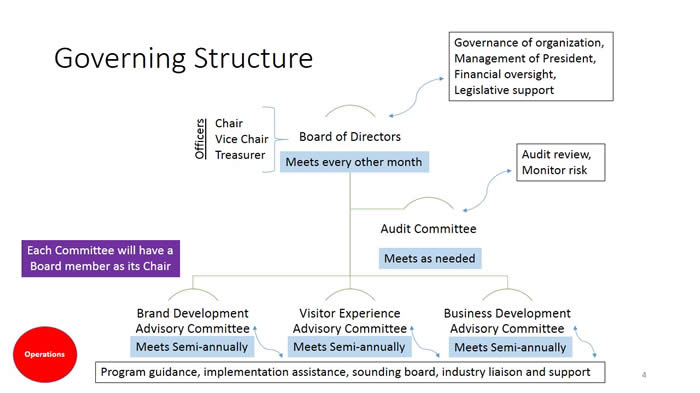
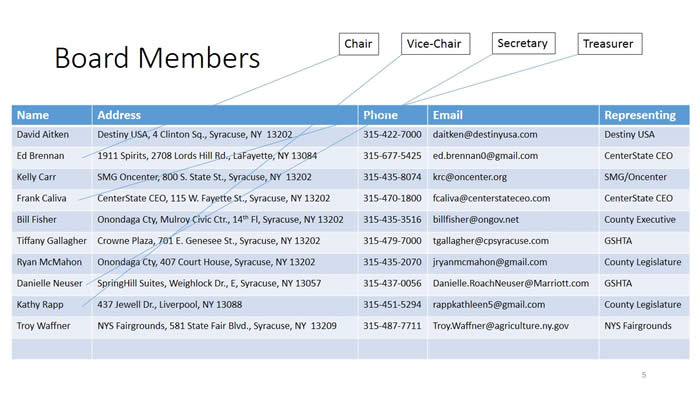
- Held first board meeting 2 weeks ago, bylaws complete; director reports to the board, Visit Syracuse team members report to the director
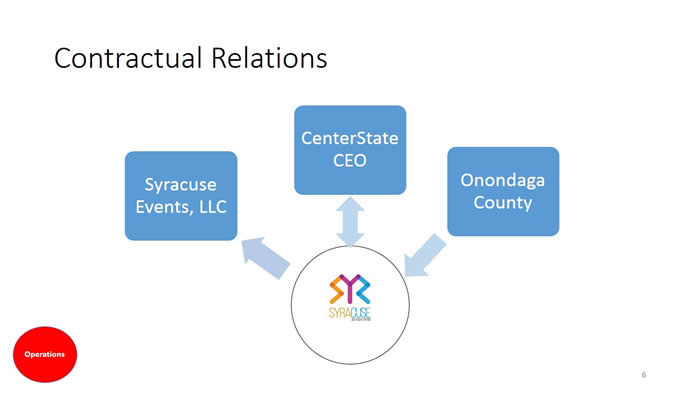
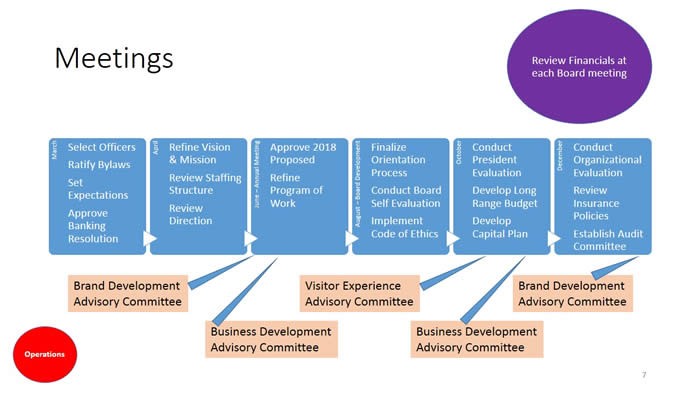
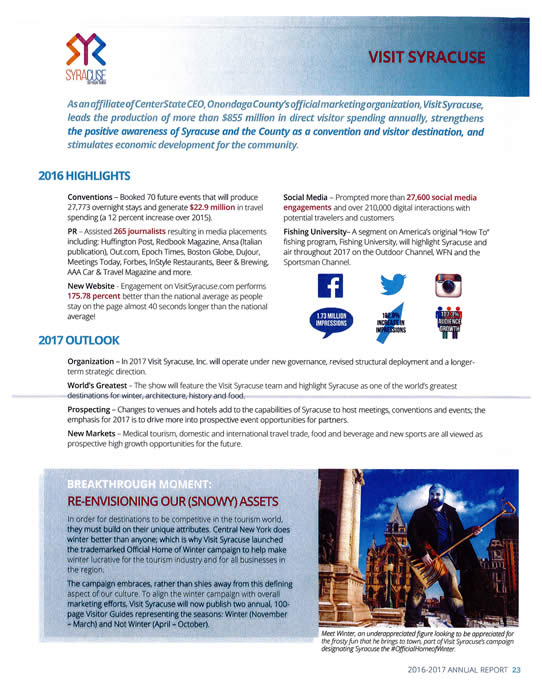
-
Introduced character named Winter, slowly grew on people, starting hearing buzz on Official Home Of Winter concept
-
Long-term plan to transform November through March: 1st year create buzz, 2nd year make community come to life; brand ambassador working with businesses to create immersive situation
-
Redefining winter months spills over into not winter months – created first Not Winter 2017 Syracuse Guide
In answer to Mr. Jordan, Mr. Holder confirmed that they would now publish two guides instead of four. It saves a little time and money, though the Not Winter guide was expanded by more than 20 pages and now has a magazine format with more articles.

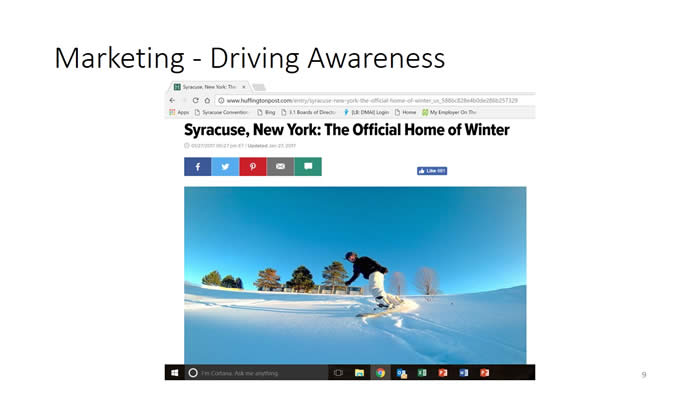
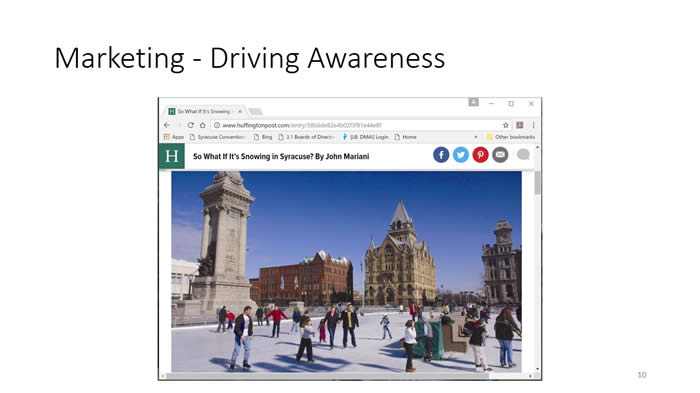
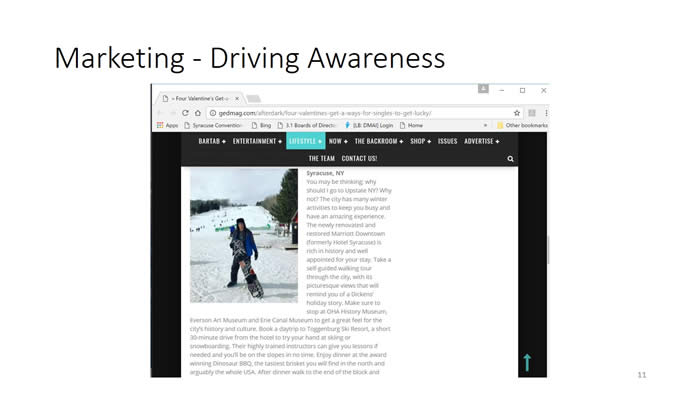
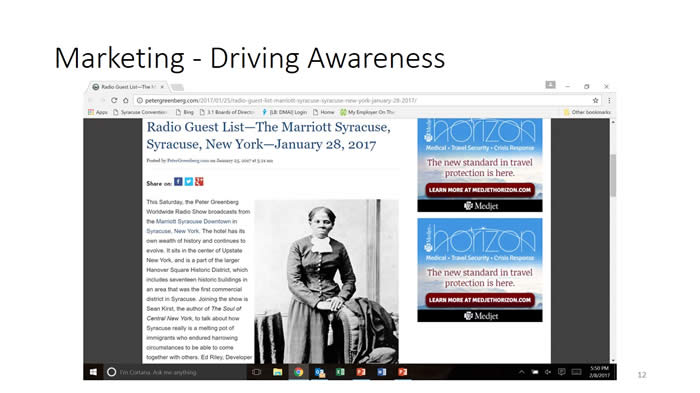

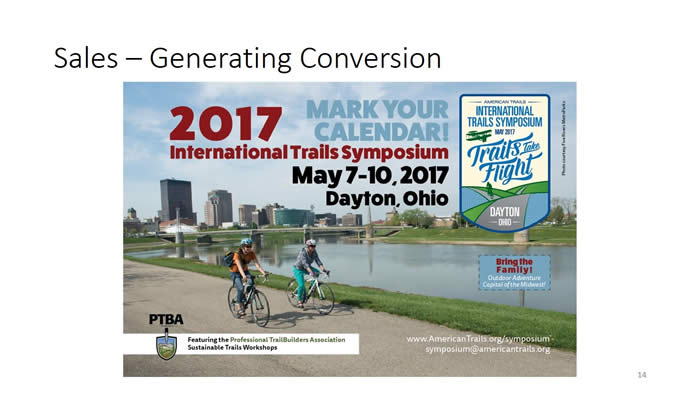

-
Sales team pushing forward on many different fronts, currently trying to finalize 3 leads, all large multi-property business, takes many different parts to move them together
-
International Trail Symposium 800 person event, 4 nights - showcases Loop the Lake Trail to the world, working to finalize 2019 FFA event, hosting 2018 US Bowling Congress Open Championship – major investment made to bring in event, 70,000 bowlers with approximately $70 million dollars in spending between March and July


-
Contracted with tour development company to grow group tours, opportunity to showcase international assets, seeing potential in UK, Canada, China and India; 9 day itinerary developed in collaboration with other NYS destinations as part of international presence; hotels now seeing business from these relationships
- Service team creates satisfaction - drives business as visitors want to come back or tell others
In answer to Mr. Knapp, Mr. Holder said that construction for the bowers would start in December and the Oncenter will be shutdown. Revenues normally expected at the Oncenter won’t be there for the course of those months - they will need something to help them along. Visit Syracuse will also need a little more in their budget to create the right visitor experience. They talked to Mr. Fisher about putting together a budget package, well in advance, so all know what this side of the scenario looks like. There are costs to generating the right experience for 70,000 visitors. Mr. Fisher said that both the Oncenter and CVB asked for more money the last time the bowlers were here. It is an awkward conversation to have in the middle of the year. Now they will be projecting the shortage within their budget and not surprising anyone.
- Large scale events vital but large time hogs, previously caused months of production to be lost, new plan rolling out in May - shifts some team members out of current positions and into event capacity, large portion of job will be solely focused on event, rest of the team will focus on the future
In answer to Mr. Jordan, Mr. Holder said that the Oncenter has already shifted some events, i.e. Auto Show. The construction schedule is minimal in December but hits hard in January, pretty much closing the entire building. This event will use every inch of space in the Oncenter, unlike when the women’s event was here in 2011- ballroom was still open and could hold other events. VIP bowling will now be in the ballroom.
Mr. Knapp asked the teardown timeframe. Mr. Holder said that they are working on getting other events for early August, late July; about two week teardown. Torn down materials are donated to Habitat for Humanity, they also buy from local vendors and use much local labor.


-
Intense conversations with Destiny USA and NYS to create Visitor Information Center at Destiny, estimate it will happen by fall, no investment for Onondaga County - Visit Syracuse partnering with the state
In answer to Mr. Jordan, Mr. Holder confirmed that the Visitor’s Center would be located within Destiny. It will likely be a mixture of both retail space and kiosk. Mr. Jordan asked if the state was paying the rent. Mr. Holder replied that Visit Syracuse will be the operator but the state will be a major partner – still have to put a lot of pen to paper. Mr. Jordan said that there will be zero local costs for operation. Mr. Holder said they anticipate that to be the case. The business plan they have been pushing calls for enough state support to make this self-sustainable and includes retail, i.e. Visitor Syracuse and Destiny USA souvenirs, full line of winter items.
- Challenges: 1) Demand not keeping up with supply - enormous hotel supply, will increase over 20% by end of 2018 from 2015
Mr. Knapp asked when the Destiny hotel was opening. Mr. Holder said that it is supposed to open this September or October and is part of the new supply they are looking at. Mr. Jordan said that a second hotel will be opening in the Inner Harbor. Mr. Holder confirmed that was correct, adding that there are projects still coming.
-
All must focus on driving demand via awareness, 2) Investment not keeping up with competition - must look at innovative partnerships and how to structure entire development program for the future, 3) Changing perceptions of immigration market – national immigration issues having trickle done effects on travel and tourism, NYC already seeing 10% decrease in future bookings, Toronto schools restricted travel to the US, 4) seasonality - extreme, large drop in business November through March, shifting resources and focus to winter for major trickle over effect; referenced slides showing publicity generated (See page 4)
Mr. Jordan said that in reality they will never be able to compete with Vermont or the Rockies in terms of winter activities and questioned what the attraction to come here was. Mr. Holders replied that they are focused on the drive market, which basically has the same weather patterns. They are shifting perceptions, showcasing a place with both outdoor and indoor assets – great food, beverages, sporting events, festivals and performances. Created a way to bend outdoor with indoor, showcasing a community and region that is alive and dynamic during winter months. If a foot of snow comes down, within hours it has been moved out so that they can go wherever they want. They are also working on an airline partnership to assist with the snow curious market. Inviting people to experience a winter destination is not about outdoor recreation, it is about a shift of perceptions – we’re alive and ready to go, come and experience the Official Home of Winter.
Mr. Jordan asked if there was any precedent for this this - he would not buy an airplane ticket to see snow in Syracuse, if he lived in Atlanta. Mr. Holder replied that travel journalists helped shift this whole concept, there is opportunity. The Huffington Post article described all the different assets that await a visitor coming to Syracuse - becomes a weekend getaway. Press gets people talking about the area and creates more travel. This is a long-term process, anticipate at least 5% shift in winter visitation by year-three. Once journalist start talking about Syracuse they also talk about the other things to see and do, and in many cases it is heavily about food. They are able to get their attention because of winter campaign – will generate travel.
Mr. Knapp said that the County has a wonderful trail system for snowmobiling and is the gateway to the Adirondacks, which has great trails but doesn’t have many places to stay. Mr. Holder said that this campaign is huge and has opened doors that were never opened for them before.
- 5) “under one roof” - new hotel supply all under 300 rooms, significant amount of lifting required to get large conferences in play
Mr. Knapp asked how many bowlers would be here at any one time. Mr. Holder replied that 400-600 would be arriving per day, and rotate out every three days. Mr. Knapp asked if they were using all the hotels in the neighborhood. Mr. Holder replied that the DoubleTree in Carrier Circle is the designated hotel. There are players toward the fairgrounds, downtown, near the airport and even further north – will see players all over the place. Mr. Knapp said that it was good for the County to share the wealth. Mr. Holders said that even if they all stayed in the downtown area, it creates compression that pushes other hotel guest to other parts of the area.
Mr. Jordan asked if the Hotel Syracuse would be booked. Mr. Holder replied that they would not be sold out due to bowling. They encouraged them to keep some supply open for meetings and conferences - still have opportunity to book new business during this timeframe. Mr. Knapp said that it was smart to have some capacity there. Mr. Holder said that some of the events normally hosted at the Oncenter had to be absorbed by them.
- 6) Cleanliness and safety – perceptions always important, rely on County for leadership, pressured NYSDOT to keep roadways clean, need everyone to keep area clean and preempt for visitors, must start acting like international destination; 7) Uncertainty of I-81 – time period of construction frightening, particularly for conferences 2019 and beyond, have to overcome travel issues from hotel to Oncenter, must have communication plan to let potential visitors know they are open for business and to help actual visitors know how to get from one place to another, 4-years minimum, serious problem
Mr. Jordan said that if the project next to the Oncenter goes through, it will also be a massive project. Mr. Holder said that they are working with the Oncenter and Downtown Committee for conventions already booked that need access to surface lots. There are some concerns coming up - must be aggressively addressed.


- Next 5-years emphasis only on generating new demand - demand helps overcome challenges
- Shuffling programing and staff to be more strategic
Mr. Jordan asked if they had performance metrics in terms of production and how they were doing, as far as meeting those metrics. Mr. Holder replied absolutely, adding that some of those metrics can be seen in the handout (See page 3). They track convention bids going into the pipeline, sales coming out and conversion rates. Each team member is given a set of goals that they must reach yearly and those goals are boosted by 25% to get them to over perform; rewarded for over performance delivery. Mr. Jordan asked how they were doing meeting those metrics. Mr. Holder said that with the exception of one individual, they pretty much nailed it last year; conversion rate was low. Due to going after large business their conversion rate is very challenging right now; typically want conversion rate in 50% range, now below 40%. This is frightening, but has to do with going after a larger piece of business. It has to be assembled in a way that doesn’t compete against the other players.
Mr. Jordan said that they have been investing in marketing for a number of years, and asked if room occupancy was increasing. Mr. Holder replied yes. They continued to see increased inventory in 2016, though supply and demand pretty much kept pace with one another through November. In February, started seeing inventory supply really out pacing demand. He will bring performance metrics back to the committee to show how they stack up against other destinations and how supply and demand has hit them. Much supply has been added, with more on the way. The lost business report for 2016 was pretty large. They went after things they were qualified to host, but the dynamics to pull it together didn’t work.
Mr. Jordan asked what the justification was for events choosing to go to other locations. Mr. Holder replied, rooms and operations under one roof, i.e. Rochester Hyatt 500 rooms. The largest hotel in Onondaga County has 280 rooms, and at best they would only get 200 for a room block. Marriott came on board with 261 rooms, would typically see 150 of those rooms for a convention room block. Mr. Jordan said that there will never be a 500 room hotel here. Mr. Holder replied that it means they have to be focused on the right type of business - do will with religious and educational. FFA was a great group for the area, but won’t come each year. The International Trail Symposium understands they will be across multiple hotel products. Probably the last year to host bowling, due to how expensive it has become to host, and they have outgrown the Oncenter.
Mr. Jordan questioned the property next to the Marriott, which used to be part of Hotel Syracuse, noting that it would in effect increase the number of rooms under one roof. Mr. Holder replied that it is one of the new inventory items they are tracking - extended stay property planned to open in 2018.
Mr. Jordan said that the Oncenter is having problems due a loss of business to the Marriott. Mr. Holder replied that when the Marriott opened a significant amount of meeting and event space was added. Whenever something new opens everyone one wants to experience it. They are seeing the same effect with Turning Stone Casino. The Rivers complex in Schenectady and del Lago in Seneca County have created pressure on both the Turning Stone and them - looking at ways to compete against that and the other competing cities. The Marriott, County, Oncenter, and Visit Syracuse are working as the alliance to find ways to be smarter with the type of packaging offered for the events they are going after. This is where the future will be, but it has created some hurdles along the way.
Mr. Fisher:
-
Big transition happening at Oncenter, after Hotel Syracuse closed the Oncenter became a glorified banquet hall, competes with private sector and doesn’t typically bring in people outside the county – purpose of convention center is to bring outside people into the county
-
Marriott offers opportunity to change business model, will be painful, have to find marketplace niche, will be much experimentation; just as they get started facility will be taken away and given to bowler for 6 months - will have to start over
-
Mr. Carr, Mr. Holder, and their organizations have to work through what the strategy is, by 2019 or 2020 should have it figured out; not unexpected to be “loosing” business to hotel – it is by design
Mr. Holder:
-
Bowling Congress coming in at great time, allows time needed to truly change systems, already going through major system shift in terms of pricing structure – many incoming groups offered free space from other cities and expect the same, nothing is free, looking at ways to make it happen for Syracuse and provide “free” convention space
Mr. Fisher:
-
Have to tie it to Economic Development - seeing signs that this can work, i.e. UTM Conference, brought in 600+ from NASA and around the world; follow-up meeting had attendees from Portland, Chicago and Buffalo who attended conference and came back to discuss drone testing facility partnerships - bringing in business that leads to collaborations, strategic partnerships, and investment with local businesses is golden snow shovel
-
Must think differently, Mr. Holder must consider how this will lead to opportunities for business in sectors where state money is being invested, Mr. Carr has to figure out how to get these folks introduced to people in area businesses, i.e. Agrana, and how to get local business to see the Convention Center District as an asset to grow their business
-
Large mind shift from what the Oncenter has been used for, steady pressure needed to replace old way of thinking
Mr. Jordan questioned the condition of the Oncenter - heard stories about things not working or being worn out, i.e. torn carpet. Mr. Fisher said that SMG delivers an updated 10-year capital plan each year. From this the County builds out the 6-year plan that comes over to the Legislature each year as part of the CIP; carpet and lighting are on that list. They applied for, and were awarded, a state grant last year totaling $975,000. These funds will be matched by money already appropriated: $250,000 per year in capital reserve taken out of room tax, facility use fees, and bond funding from 6-year CIP. They have a plan to improve technology for the informal space between meeting rooms and audio visual capabilities - won’t be to the standard of the Marriott, but want to move in that direction so that it feels like one unified modern experience. They are working to strategically bring the Oncenter up to where it needs to be, using SMG’s guidance, with the funds allotted.
Mr. Knapp asked if the piece of the state budget concerning Visit Syracuse was more or less. Mr. Holder replied that it has opened up more opportunities. The state investment in tourism has never been this high, but they must compete for every dollar received; $975,000 awarded was a competitive grant. They are on the right track, but need to make certain the programs they are putting forward really attract the attention of the state. The state loves the winter program and connected them with potential airline sponsor. It opened doors and they need to look for more ways to create those avenues. Mr. Fisher said that the big thing is the fair - putting in another $70 million and trying to expand beyond the fair and Syracuse Nationals. They are also trying to improve some of the transportation problems; improving orange lot and access to 690 West, hope to then improve 690 East. Looking to create a Disneyesque type of thing with the gondola, which is being used for more than transporting people. It is being used to create a relationship between the park, lake, and fairgrounds.
Mr. Fisher said that they are also working with the state to make sure the Expo Center is programed and built in a way that doesn’t compete with the Oncenter. They have been assured that the intent is for equestrian events and have a very good relationship with Troy Waffner, whom is also on the Visit Syracuse Board. Mr. Holder said that he and Mr. Waffner just discussed having a shared person between Visit Syracuse and the fairgrounds, focused solely on pursuing equestrian related events. It takes a very different set of skills, relationships and knowledge to go after that type of event. Want to connect this so that events aren’t just utilizing the fairgrounds as space, they are using the entire community as an opportunity.
Mr. Fisher said that they have also been conferring with the Canal Cooperation to get people to understand that they can get out of the water when they come here. They can get onto a boat, get off at the pier, attend a concert, and take a gondola to the fair. Whenever this type of large project comes along there are always questions. However, this is to draw people here and make a memorable visitation experience so that they want to do it again or tell their friends. Mr. Holder said that they are thinking like a destination.
The meeting adjourned at 11:44 P.M.
Respectfully submitted,

KATHERINE M. FRENCH, Deputy Clerk
Onondaga County Legislature
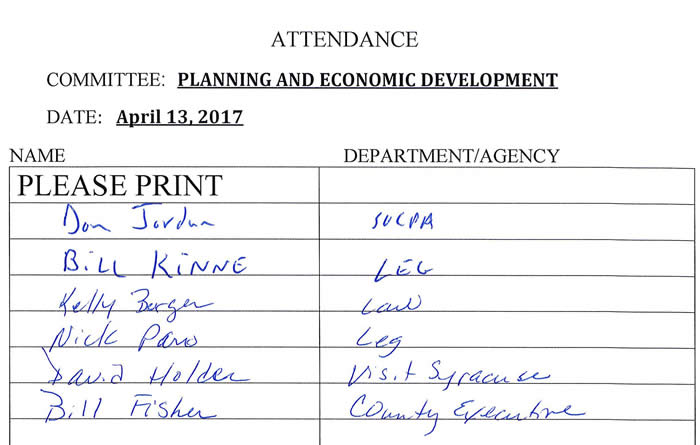
* * *
HEALTH COMMITTEE MINUTES – APRIL 19, 2017
DANNY J. LIEDKA, CHAIRMAN
MEMBERS PRESENT: Mr. Burtis, Mr. Holmquist, Ms. Williams
MEMBERS ABSENT: Dr. Chase
ALSO ATTENDING: see attached list
Chairman Liedka called the meeting to order at 9:35 a.m. A motion was made by Mr. Burtis, seconded by Mr. Holmquist to waive the reading and approve the minutes of the previous committee meeting; MOTION CARRIED.
1. CHILDREN AND FAMILY SERVICES: Jennifer Parmalee, Deputy Commissioner
a. Amending the 2017 County Budget to Make Funding from the New York State Office of Mental Health (NYSOMH) Available for use by the Department of Children and Family Services, and Authorizing the Execution of Agreements to Implement this Resolution
-
Accepting money from NYS Office of Mental Health to support transfer from Kasson Road Day Treatment Program to Syracuse City School District McCarthy Program
-
Also supporting students in OCM BOCES, and expanding support to all schools in Onondaga County
- Increasing mental health services, which includes mental health clinic satellites and care coordination; case management services; all are Medicaid billable
Chairman Liedka asked Ms. Parmalee to give the committee a quick breakdown of the transfer from the Kasson Road Day Treatment Program.
Ms. Parmalee:
-
County operated program for years, which used to be housed at Hutchings - considerable support for high level of safety
-
Day treatment is a therapeutic environment and educational setting in one; helping kids with mental health challenges who are often eligible to live in residential setting, but working to keep them in the community
-
2 years ago, Hutchings under construction, so needed to find new location; moved to Kasson Road; unable to maintain safety for kids and families; safety related to physical plant and lower level staffing; did not have Hutchings’ security
-
Decided to transfer students out of Kasson Road; bolster support and services in Syracuse City School District and BOCES; provide close to same level of support and services in safe settings
-
McCarthy chosen because of deep level partnership with Syracuse City School District; district willing to provide additional staffing and support; McCarthy the best site
A motion was made by Mr. Burtis, seconded by Mr. Holmquist, to approve this item. Passed unanimously; MOTION CARRIED.
The meeting was adjourned at 9:40 a.m.
Respectfully submitted,

JAMIE McNAMARA, Assistant Clerk
Onondaga County Legislature
.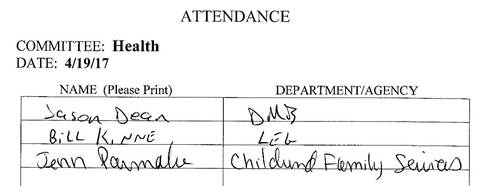
* * *
WAYS AND MEANS COMMITTEE MINUTES
April 24, 2017
David Knapp, Chairman
MEMBERS PRESENT: Mr. Shepard, Ms. Williams, Mrs. Ervin, Mr. Kilmartin, Mr. Jordan, Mr. May
ALSO PRESENT: Chairman McMahon, Judge James Murphy, see also attached list
Chairman Knapp called the meeting to order at 9:04 a.m. A motion was made by Mr. Kilmartin, seconded by Mr. Jordan, to waive the reading of the minutes of the proceedings of the previous committee. MOTION CARRIED. A motion was made by Mr. Kilmartin, seconded by Mr. Jordan, to approve the minutes of the proceedings of the previous committee. MOTION CARRIED.
CONSENT AGENDA
1. SHERIFF:
a. Amending the 2017 County Budget to Accept Drug Enforcement Administration Funds for Cannabis Eradication Work Performed by the Air One Program of the Onondaga County Sheriff’s Office, and Authorizing the Execution of Agreements ($15,000)
b. Transfer from Sheriff’s Office, Account 666500 Contingency, to Sheriff’s Office, Account 693000 Supplies & Materials, $300,000
2. CHILDREN AND FAMILY SERVICES:
a. Amending the 2017 County Budget to Make Funding from the New York State Office of Mental Health (NYSOMH) Available for use by the Department of Children and Family Services, and Authorizing the Execution of Agreements to Implement this Resolution ($481,789)
Chairman Knapp moved item 3 to the regular agenda.
A motion was made by Mrs. Ervin, seconded by Mr. Kilmartin, to approve items 1a, 1b, and 2a. on the consent agenda. Passed unanimously; MOTION CARRIED.
WAYS AND MEANS COMMITTEE REGULAR
3. TRANSPORTATION: Marty Voss, Commissioner
a. Amending the 2017 Onondaga County Budget to Accept Funds from New York State’s State and Municipal Facilities Program to Provide Improvements at the Lakeview Park & Amphitheater, and Authorizing the Execution of Agreements ($500,000)
Mr. Jordan said that this is for grading, paving, extending the lake trail, increasing signage, lighting, and benches, and it seems like that will cost more than $500,000, and asked what the overall cost is. Mr. Voss said that the projects that DOT is managing under this grant will not exceed the $500,000 that has been allocated. He said that they are hopeful they can do all of the walkway paving with the term contractor to make them asphalt paving. Hoping to come in under budget and address a couple of other things.
Mr. Jordan said that normally these things would come under the Parks Department – it’s not roads. Mr. Voss said that this is a county park, and a lot of other work is done in the parks through the year that is probably not heard about. This came through DOT because it has the term services paving contract; the mechanism for getting the work done; the money is coming through DOT to pay the contract. Mr. Jordan said per the terms in the resolution, it goes beyond paving; things that would come to the legislature by virtue of County Facilities Committee through Parks Department. It doesn’t make sense that it would be part of the Highway Plan for 2017.
Mr. Kilmartin said that DOT makes a lot of purchases other than asphalt and salt during the year. If any of these specific purchases aren’t exactly in DOT’s wheelhouse, he guessed that they would use resources/contacts in Purchasing, Parks – find the best vendors and follow the normal course. Mr. Voss agreed, and added that Purchasing manages the bids for their term services contracts as well. Mr. Kilmartin asked if for things like benches, etc., would DOT have the personnel to help administer the installation and purchase of those. Mr. Voss said that they would. In answer to Mr. Kilmartin regarding concern of any uncertainty, Mr. Voss said that he did not have any and noted that he has a very good staff and are fairly certain that this is a relatively minor project for them.
Mr. Kilmartin asked how this project will help improve the aesthetic, walkability, and drivability issues at the amphitheater. Mr. Voss said that there two things driving it. The dust – if there is a dry summer, stone dust with thousands of people walking—won’t have the dust if paved. ADA accessibility – challenging to walk on run-a-crush and stone dust – should be a lot easier and smoother on asphalt directly from parking lot to facility on the walkways. He said they are very grateful to the Assembly sponsor on this. Mr. Kilmartin referred to the water trucks having to be brought in last year and asked if these improvements will eliminate to a degree the need to do that. Mr. Voss said it definitely would in the large area, but will still have to do some of it. There is always going to be dust there, but it depends on the weather. Also, if there is a very rainy summer, the asphalt will avoid the mud pit type of thing.
Mr. Shepard asked how much of the orange lot will be covered by paving. Mr. Voss said that the orange lot is a NYS owned lot; the county is not touching the orange lot – it is not ours. There is other work that is being coordinated with the State that will be done later this year, along the same timeframes as the county work. In answer to Mr. Shepard, Mr. Voss said that the state is doing 125 parking spaces, ADA compliant. Mr. Fisher said that within the county property, the improvements for persons with disabilities is in the interior pathways once past the ticket office. The parking lot belongs to NYS; county has an agreement with them to use it for concerts. Since it is the State’s, it will be their DOT and their money that does the paving, not ours. The orange lot paving won’t happen prior to this year; scheduled to be done before next year. The dust will still be in the orange lot this year.
Mr. Jordan asked if it is still the plan to basically waive the $125,000 to the County in lieu of the State paving their own land. Mr. Fisher said that if they come forward and pave the parking area, which belongs to them, but they don’t use for disabled reasons, then “yes, the county executive would be willing to essentially write-off the money they owe.” It has no value to them as a disabled area, but has great value to our customers; we would have to put our own money into that and it is necessary. Mr. Jordan said that this legislature sets the policy and the county executive shouldn’t be deciding “I’m going to forego what the state owes us so that they can improve their own property, for arguably the benefit of county taxpayers.” It seems like it is something that should be decided by this legislature. Chairman Knapp said that is a discussion we will need to have when the time comes, if it is an issue, but it is not germane to what we are talking about right here.
Mr. May said that the waiver of the $125,000 from all intents is conditioned upon that lot being paved. Mr. Fisher said that the preference is that the State pays that and everything else they owe, but it takes a long time. He noted that the dasher boards from 2013 were received last year. The plan is for them to pay it, but if it is going to take another 1 – 3 years, which seems likely, and they are saying they don’t have any reason to pave this area for our concerts but are willing to do that with State money, then as consideration we could write off the money they owe us. We are open to that possibility; seems like a simpler way to address bureaucratic stuff that happens when you try to get reimbursed by the State. Chairman Knapp said that we will cross that bridge down the road.
A motion was made by Mr. Kilmartin, seconded by Mrs. Ervin, to approve this item. AYES: 6; ABSTENTIONS: 1 (Jordan); MOTION CARRIED.
1. ONONDAGA COMMUNITY COLLEGE:
a. Calling for Public Hearing on the Tentative 2017-2018 Budget of Onondaga Community College
A motion was made by Ms. Williams, seconded by Mrs. Ervin, to approve this item. Passed unanimously; MOTION CARRIED.
2. FINANCE, DIVISION OF REAL PROPERTY TAX SVCS.: Don Weber, Director
a. Approving and Directing the Correction of Certain Errors on Tax Bills
- Correction to tax bill, Town of Geddes apartment buildings
- Assessor thought there were 18 apartments in the building and there are only 9; they were being overcharged for sewer unit charges
A motion was made by Ms. Williams, seconded by Mrs. Ervin, to approve this item. Passed unanimously; MOTION CARRIED.
3. ASSIGNED COUNSEL: Kathy Dougherty, Executive Director
a. Amending the 2017 County Budget to Make Funds Available for use by the Onondaga County Assigned Counsel Program ($4,284,821)
- Asking acceptance of the $4.2 million that the state has authorized for caseload relief money under Hurrell-Harring
Chairman Knapp said that he thought there was more money. Ms. Dougherty said that in total there were 3 different areas that were being funded: $275,000 counsel at arraignment for last year, which will basically double this year; $432,000 for quality of indigent defense; $4.2 million being asked for today; and roughly another $1 million that was fronted for training and mentoring programs that the state already provided – a total of roughly $6 million. This is the last of if for this year.
Mr. May said that this was discussed at length at Public Safety Committee; Judge Murphy came to the meeting. A good job was done in convincing him that the funds should be accepted, but there is a concern that there are costs associated with the settlement to the county, to local municipalities, etc. Judge Murphy and Ms. Dougherty did a good job of explaining that this particular pot of money was purely ACP money for indigent defense, and it is almost retro. Ms. Dougherty said that it is retro. Mr. May said that his concern is that there are costs associated with the settlement that we have to pay for and account for in some way. It has to stay at the forefront because there are concerns from every facet of this process with respect to everyone’s ability to comply. He asked that that Ms. Dougherty explain it because it would be helpful for everybody.
Ms. Dougherty said that Hurrell-Harring lawsuit was about providing quality defense for the indigent. The county as sued for that reason and none other. The county was one of five across the state named in the lawsuit. The State was a defendant in that lawsuit. The resolution was for the state to step in and provide funding for the 3 different areas: caseload relief, counsel at first appearance (constitutional right that people have to have an attorney present for an arraignment), and counsel/training for it. There was no consideration in the lawsuit for how it might impact the judges or Sheriff’s Dept. She said that when she worked for the County Law department, they tried to get the plaintiff to bring the judges into the lawsuit, because the plaintiff and the state were making demands of the counties. The county doesn’t have any ability to direct how judges are going to behave or whether they would agree to what was being demanded by the lawsuit. The plaintiff refused -- it was about the focus of quality indigent defense. She agrees that some of the requirements may have some financial impacts on other agencies and departments, but for purposes of the lawsuit that was decided by the State, who was making the funds available, it was something that they weren’t going to address as part of the settlement. Mr. May asked if they consciously decided that they weren’t going to address the local costs associated with this. Ms. Dougherty said not the local costs, but the impacts associated with it. The County was being told that they had to come up with a plan for how judges were going to require, demand, and expect that an attorney was present for an arraignment 24 hours/day, 7 days/week. Essentially the message back was to shove a plan down the judge’s throats. She said that they have tried to work as partners with OCA, with magistrates, but don’t have a funding stream for them. There has been a lot of discussion about other funding streams, but not through the lawsuit. Judge Murphy said that it may have changed in the last budget; have tried hard to figure it out – in Onondaga County it is $95k to pay the judges. There were supposed to be funds for that, which would allow Onondaga County to go to centralized arraigning--a much more efficient and less costly alternative. No one knows until that money has been approved – hopes to find out in the next day or two from ILS. He said that they have changed the executive law to essentially take all of the other counties (non-settling counties) to exactly where Onondaga County is. They have come up with this funding for the non-settling counties to essentially maintain their payment level. Then ILS has to come up with a plan for each of them by December 1st. They will pick up the difference in the payment supposedly, and have allocated $250 million to that.
Judge Murphy said that this piece of where we are right now is accepting $4 million of last year’s money; Assigned Counsel program needs to pay its bills. He said that he is present as a member of the Assigned Counsel Board and was actively involved in putting together the response and proposal to the County. His concern is that very soon, they will not be able to live up to the obligations in the proposal because the County is not funding it. The good news here is that because it is later in the year, with $4 million, there is going to be leftover money, because they can’t spend it, unless they can start doing some of the things that they all want to do --helping the Sheriff, addressing transport issues, etc. Once they get the money, that is a different argument. That is different than not accepting it. By not accepting it, we don’t get to make those arguments.
Mr. May said that he will support this today, but stated for the record that he is still very concerned and confused on other aspects of this. He said that he gets the main point that this is something that we have to do.
Mr. Jordan asked if the proposal for centralized arraignment have to be approved by Albany. Judge Murphy said that it does not in Onondaga County. It does in some of the other counties because the Sheriff has authority to hold until arraignment; that actually works and the legislation has passed. Because of the timing of this, it is in the middle of everybody’s budget year, and the courts did not have the $95,000 to pay the magistrates, nor do they want to assume that obligation statewide without some understanding on where it is coming from. They believe it is a constitutional obligation and should not be part of the judiciary. It was the argument being made in the last budget, but does not know how that came out. Once the $95,000 is solved, there is an issue of transport and with the DA’s office of local funding for those two components. They have explained rationally that there is going to be increased costs in the local budget. The Sheriff and DA were loath to agree to that without somebody telling them where that money is because they don’t have it budgeted for this year. There isn’t a legal obstacle; there is a payment obstacle. Mr. Jordan said that is holding up centralized arraignment. Ms. Dougherty and Judge Murphy agreed.
Chairman McMahon said that this is really an unfunded mandate by the State of New York; this was a lawsuit and the Governor vetoed legislation that would have solved it. By accepting these funds we are minorly complicit in this mandate. It looks like some of it might be covered in the budget. In answer to Chairman McMahon, Judge Murphy said that the centralization arraignment was $600,000 and counted everybody – Sheriff and DA. Chairman McMahon asked if this money was going to be spent this year. Ms. Dougherty said that the intention of this money was for this time last year; they are a year behind and haven’t implemented most of what this funding was for. Chairman McMahon asked if it was for paying the lawyers more money. Ms. Dougherty said that that the rate is always the same and set by the state, but a case cap is going to be implanted so that the attorneys can only handle so many cases. The expectation is that they are going to do more on the cases that they have been assigned. Also, the eligibility was greatly changed, and there are non-attorney support services i.e. translators, investigators, and social work type experts. The plan is to have contracts with them, so they are used more frequently. She said that they are also required to expand the number of people in ACP and increase their space, which is a big cost.
Chairman McMahon asked where the money goes once accepted. Ms. Dougherty said that it goes to the County; Chairman McMahon said that then County passes it off. He said for the record that this settlement doesn’t cover the costs; this is absolutely and unfunded mandate. The County is getting money because it agreed to settle, and probably wouldn’t have agreed to settle if some of unintended consequences were realized – could have fought this in court. There is no way to slice and dice the money to cover the costs. Ms. Dougherty explained that the other part of the $4.2 million is that they have to have a plan with the State; the plan is reviewed of the state budget office. Based on the plan, the County and State enter into a contract. There is really no mechanism to slice and dice. Judge Murphy said that he didn’t necessarily agree. There is a very good argument to be made that the plan that Onondaga County submitted in November 2015 should be revisited. Now there is legislation in place in the State of New York that allows for a centralized arraignment department – that could not/did not exist in November 2015. In theory the whole basis of the $4 million was that they thought they were funding a plan created in 2015. The law has changed now. If it isn’t all spent because of the delay in RFP and different issues, the reallocation argument is one that hasn’t been successfully made behind the scenes -- but that was even before the law changed. Now that the law changed to allow centralized arraignments, it seems rational that the County should be allowed to allocate these funds to fund the new legislative plan. That argument has never been made.
Chairman McMahon said that this is two pots of money. Budgetary funds-- making sure that it comes to us. This money created all sorts of efficiencies in ACP budget potentially; is it a second bite at the apple to try to absorb some of these funds, i.e. if the legislature cut ACP budget by $90k - $100k to offset it. Judge Murphy said “no, because we have no funds.” ACP has no funds other than what the county gives it. Chairman McMahon said that he wouldn’t cut it to send a message; would cut it to give money to the DA or the Sheriff. Judge Murphy said that he didn’t think it would be done that way – that it is the administrative component. Ms. Dougherty said that there is a requirement under the settlement that the County continues to fund everything that it has been funding.
Mr. Fisher said that he was sent to Albany 2- 3 years ago by the county executive. In the course of negotiations Gordon Cuffy led this and reported to the county executive. He said that they were assured repeatedly that the County of Onondaga would not be harmed – that there would not be an unfunded mandate, and there is not; “there is no unfunded mandate on us.” Chairman McMahon asked where the funding is for the Sheriff’s office and DA’s office. Mr. Fisher said that they are in these dollars, if they have any extra costs. He added, “If they bear any additional costs as a result of the settlement, the State has promised us that we can take funds and make ourselves whole.” Chairman Murphy asked where Mr. Fisher got that promise, and added that he met with ILS three times--has gone to Albany and has argued it. They have told him that no funds can be used for the DA and for transport. Mr. Fisher asked if the DA and Sheriff anticipate additional costs. Judge Murphy and Ms. Dougherty stated that they do. Judge Murphy said that approximately 3 months ago at the stakeholders meeting they had everybody in the room ready to go with the centralized arraignment part. The district attorney showed up and said that he didn’t have money in his budget to cover it. The Sheriff, very firmly, stated that he needed 3 more transporters to accommodate this. Certainly there is an increase in the Sheriff’s resources.
Mr. Fisher said that the insurances that Gordon Cuffy were given was that the settlement by NYS would not adversely impact this County. Judge Murphy said that they went down last year with a less costly, more efficient way of doing this with the centralization arraignment court, and should be able to slide the funds over. He said that they received a categorical “no”. Ms. Dougherty said that when Mr. Cuffy made the representation, passed it from the State, at the time the plan for counsel at first appearance didn’t include, because it didn’t need to, the additional costs for the Sherriff’s transport and additional costs for the judges. In order to change the plan to make it a centralized arraignment court, a much more efficient process, there are some other costs that were not part of the off hour arraignments that they currently have. Mr. Fisher questioned who realizes the efficiencies and who benefits. Ms. Dougherty said “virtually everyone.”
Chairman McMahon said that in the original plan to do the central arraignment, the number wasn’t $600k, it was about $1 million – nobody factored that in during this process. The pitch is that Onondaga County is a part of the settlement, and we don’t have any bandaids on this. He suggested coming back with legislation accepting the $4.284 million, hold $600,000 in contingency that we can use to offset all of our other costs. He said that if that can’t be done, then this is absolutely an unfunded mandated. Ms. Dougherty said that there is nothing in accepting the funds that has anything to do specifically with centralized arraignment. She said there is currently a process by which 14 attorneys are on call around the county every day with phones. The judges are called when there is an arraignment. This is already in place – already performing under the settlement agreement; it costs money to do that. The $4.2 million is to assist the County with all of the other improvements required under the settlement. For sake of argument, centralized arraignment is a better way to do off hour arraignments; it is not part of caseload relief money; you would be holding up accepting this fund that is not part of centralized arraignment. Chairman McMahon said that he understands and is clarifying what is really happening.
Mr. Kilmartin said there has to be compliance with the settlement and how it was drafted at that time. Since that time the County, courts and other entities have built a better mousetrap, which is probably much better for the entire criminal justice system, defendants, prosecutors, defense attorneys, Assigned Counsel, and the towns and villages will benefit. Maybe there is an opportunity, especially if the State had made verbal representations to the county executive’s office, to bring county executive’ office, Assigned Counsel, County and OCA together to try to advance a contract with the state. He suggested that maybe there is a way to build into that contract if there are any residual funds left in there, that some of them can be utilized by some of the other costs that this County is incurring as a result of building a better mouse trap to comply better with the settlement terms. Judge Murphy agreed and said that he was encouraged by Mr. Fisher’s statements, because ILS people keep telling them that the only way to reallocate is to get the permission of the plaintiffs, which is the New York Civil Liberties Union, and they won’t agree to anything. To the extent that those promises, then the County can help with the re-allocation. He said that he wanted to underscore that we needed to accept the money – get it in the county coiffeurs and then can argue about how it gets distributed and where it should go. Mr. Kilmartin said that there are arguments to be made to the plaintiffs and to the judge, who signed off on the settlement, saying that the whole thing was a result of trying to get better representation for defendants – quicker, more efficient, less time in jail, etc., but to expedite the process we have some residual costs that are going to be immediate and maybe reoccurring.
Chairman McMahon said that the only thing sustainable is the $95,000 if that’s in the budget year in and year out. We are talking about, depending on what our Sheriff and DA wants, $300 - $400,000, not just this year. He asked Ms. Dougherty if this is one time money. Ms. Dougherty said that they get this every year for 3 years. Judge Murphy said then it follows what was just finished last week, where it was the same theory – the original amount and then anything above and beyond is going to be covered by the State. That is what they are doing with the other 57 counties. Mr. Kilmartin said that it is an indirect unfunded mandate that came about from our building the better mousetrap that resulted from the settlement of the case. Chairman McMahon said that the mandate would be even greater if a more efficient process wasn’t figured out – close to a $1 million local. This has been an intellectually dishonest argument from the State of New York – saying that this settles our problems in Onondaga County.
Judge Murphy said that the bid issue goes back to the Nov/Dec 2015 plan – no one knew what they were doing. No one spoke to the police. Ms. Dougherty said that she did. Judge Murphy said that he can categorically say that no one spoke to the courts. Mr. Fisher said “I know that Judge Tormey was aware.” Judge Murphy replied, “If Judge Tormey was aware, he wouldn’t have been yelling at me repeatedly that he wasn’t aware.” Mr. Fisher said that Rick Trunfio and Jerry Neri had conversations at that time, and he has it in writing that he was bringing that information back – prior to the plan being adopted – at the time when Gordon Cuffy was county attorney, and he was was being sent to Albany to represent the county executive. Judge Murphy said that he was involved in a lot of the details and has a different recollection. What they funded in 2015 is not what anyone is trying to implement, and that is the difference. There is no argument that $4.2 million is not enough; now there is a better plan; need to get it reallocated.
Chairman Knapp said that he and Mr. May have done quite a bit of work on this behind the scenes. This conversation needs to be had. It could have a significant impact on us down the road.
Mr. May stated for the record – we are talking about implications for for the County, but from day one none of us can lose sight that there are implications on the local level as well. The towns, villages with police, and courts are impacted as well. There are broader, deeper implications – doesn’t proclaim to have the answers; it is confusing. He said “we can’t lose sight on the fact that they are hoping we get our act together on all of this.”
Mr. Jordan said that his understanding is that they arrived at the $4.2 million based upon assumptions that have to do with cost of implementing the settlement. They broke it down - $2.5 million for counsel at arraignment; $865k for quality improvement; $4.3 million for caseload relief. We can’t exceed any portion. We came up with a plan where our costs are less than the original numbers were based upon – i.e. counsel at arraignment is $2.5 million, but only allocated for $565,000/year; if there are additional costs to us from the DA and Sheriff of $600,000, it would completely exhaust the yearly allocation. If there were savings in counsel at arraignment, an argument can be made that whatever savings we realized could then be used to pay for the Sheriff’s department and/or DA’s office related to arraignments. The problem is that the overall cost far exceeds the $560,000/year so there’s not going to be any access monies that we could allocate. The only potential would be if we could take money from the quality improvement or caseload relief allocations if savings were realized there. The holdup is that they won’t allow us to take money from one of the other categories and move it over.
Ms. Dougherty said it is being spent at a much faster rate right now because there are 14 attorneys around the county. Under the consolidated courts approach that money would not be spent at that quick of rate – there would be 2 attorneys and possibly one person on the phone. There may be a savings that could then be used. Mr. Jordan said that if $565k is anticipated as the cost of having 14 attorneys, then if for example, with 2 attorneys it costs $100-$150k, there is excess money of $450k. If the additional cost to the Sheriff and DA’s office is $600k – it would only allow coverage for half of the additional costs associated. Ms. Dougherty said that she doesn’t have any estimate that the funding for the transport and DA would be that high. The funding for counsel at arraignment is really where the funding is that we would want to try to talk about pursing out some of it. Caseload relief if not for the centralized arraignment part.
Ms. Dougherty stated for the record that there are actions that ACP has already taken that implement the funding that so far we haven’t accepted. She said that she has two attorneys working who are funded by this caseload relief money that she doesn’t have yet. She said that she is supposed to hire a CFO, and has extended an offer - the rate that ACP is paying, and has been paying since October, has doubled. They had to move into a bigger space because of hiring more people. She said that they are still only getting the funding that the County provided. All of these things are provided for in caseload relief money that she doesn’t have. “We have hit rock bottom; we have literally bounced paychecks.” There have been significant implications because this funding has not been accepted.
Mr. Jordan said that if it ends up that through centralized arraignment it was cut in half, is there any anticipation that we get push back from utilizing the additional monies there to offset some of the costs. Transporting defendants and DA’s being there is all part of the arraignment process; seems that any of the money could be used for the arraignment process. He asked if it is anticipated that they won’t see it that way. Judge Murphy said that the more we talk about going forward, the more we get lost in where we are today. He said they expect to be back in the next month or so for another $4 million because that is now catching us up to going forward. This is all money that was for last year. Regarding Mr. Jordan’s question, Judge Murphy said that the settlement agreement is really silent on it. ACP has roughly a $5 million obligation; if they save money for some reason – he questioned who gets credit of it – is it the county or the state. Some people have argued that there should be a conference with the settlement judge again – go back and bring these issue up. Right now ILS will tell you that they will not agree to it unless the plaintiff’s lawyer agrees to it, and the plaintiff’s lawyer hasn’t agreed to anything. Mr. Kilmartin said that they don’t have any incentive to agree to anything because they got their settlement and could care less how it is administered. Ms. Dougherty said that they care very much on how it is administered. Mr. Kilmartin said “with their part of the administration; they don’t care about other satellite issues, which will impact them like the DA’s office and transport.” He said that the only way to get their attention is to go back to them as part of a holistic solution and say – we built a better mousetrap, here is how it will impact you and your clients - work with with use to help advance this greater good.
In answer to Mr. Jordan regarding counsel at arraignment, Ms. Dougherty said that there is a plan in place approved by state budget office and incorporated into a contract. There is a separate contract between the County and the State for counsel at arraignment. There is also a separate contract for quality improvement between County and State; it incorporates a plan. The plan for counsel at arraignment is the off hour arraignment phone call system. That can be modified and would incorporate the centralized arraignment; that is where the fight is for how the funds will then be distributed. That is where the argument comes up - additional transport costs, judiciary costs, may need a support person in the centralized court. She said she thinks they would draw the line at paying for assistant district attorneys. That’s where the fight is – “here’s the cost, it doesn’t cost you an additional penny, but it is a far better program.” ILS totally agrees that a centralized court is a better plan. Mr. Kilmartin said that they are going to be hesitant to take some of their funds away from indigent representation to give to DA’s or transporting. Ms. Dougherty said that she doesn’t think it is insurmountable.
In answer to Mr. Kilmartin, Ms. Stanczyk said that the $4.284 million includes the $13,000, which wasn’t included in the 2017 budget for year two funding. It does not include the $2.5 million for counsel on arraignment – that was last year’s allocation. Mr. Kilmartin said that this money is using to back fill those obligations and then go forward. Ms. Dougherty agreed.
Ms. Williams said that the resolution before us today is for the things that have already occurred or are just waiting to occur, but then there needs to be further conversation about centralized arraignment. Ms. Dougherty agreed – this is for things that have already started, i.e. hiring. All things that were part of the proposal; there was an RFP. In answer to Mr. Jordan, Ms. Dougherty said that this was for April of last year to April of this year. Chairman Knapp said that we think there will be more money coming in as part of this new budget. Ms. Dougherty said that Onondaga County is a year behind on accepting the money and implementing the changes.
A motion was made by Mr. Kilmartin, seconded by Ms. Williams, to approve this item. Passed unanimously; MOTION CARRIED.
4. TRANSPORTATION: Marty Voss, Commissioner
a. A Resolution Authorizing the Reconstruction and Construction of Improvements to Various Highways in and for the County of Onondaga, New York, at a Maximum Estimated Cost of $4,600,000, and Authorizing the Issuance of $4,600,000 Bonds of Said County to Pay Costs Thereof ($4,600,000)
- Bond resolution to support 2017 work plan $4.6 million – roads only
- $4.6 million borrowing leverages almost $26 million total
- Cash will be used for bridges (item 4b)
- Projects are evaluated on need and pavement ratings - those most in need of repair are addressed first
- Those that can possibly be saved – will do a 5 – 10 year solution to maintain and keep them as long as possible
- For every $5 on a $1 spent locally, 10¢ is received from NYS and 85¢ from the federal government
In answer to Chairman Knapp, Mr. Voss said that compared to previous years, they are down a little in money, but up in paving because asphalt prices have gone down a little. They will be paving a little bit more with less money. Last year they did 84 miles centerline; this year will do 85.83. The cost was $265k in 2016 to $240k in 2017.
Mr. Jordan said that he will vote against this – does not have a problem with the majority of the plan, but objects to including the work to be done at the west side park and amphitheater. He said that it shouldn’t be part of the highway plan – it should be part of the Park’s Department budget. Mr. Voss said that it is not included in the work plan. He said that there is nothing for the amphitheater park in the DOT work plan; it is strictly for county highways.
A motion was made by Mr. Kilmartin, seconded by Mr. Shepard, to approve this item. AYES: 6; NOES: 0; ABSTENTIONS: 1 (Jordan); MOTION CARRIED.
b. Amending the 2017 County Budget to Make Funds Available for Use in Connection with the Reconstruction and Construction of Improvements to Various Bridges within Onondaga County ($3,500,000)
- Not borrowing for bridges this year; will use tobacco settlement funds
- Local bridge projects $880k; proposed to the $880k again in 2018 bridges
- Federal Aid Project - Lake Trail Extension project, $1.6 million local share
- Federal Aid Projects – Bridges: Tuttle Road, Tully Farms Road, and Fremont Road
Chairman Knapp said that he and Mr. Jordan serve on the Tobacco Asset Securitization Board. Mr. Morgan did a lot of work on this and it resulted in refinance a lot of bonds; a win fall of $3.5 million to County. The money had to be used for infrastructure type projects.
Mr. Jordan said that he will vote against this. There is $1.6 million for extension to the Onondaga Lake Canal Trail as part of the 2017 highway work plan. He said that he doesn’t have any problem with the remainder of the plan, but that should be part of Park’s budget. Chairman McMahon said that it for the Loop the Lake Trail, extending it to the Creek Walk; there is federal money and this is the local match. Mr. Voss said that the reason it is in there is because it comes to the Federal Highway Administration, State DOT administers it; County DOT has the staff and programs to facilitate it. He said they are working in cooperation with the Office of the Environment, the driving force on the trail.
A motion was made by Mr. Kilmartin, seconded by Ms. Ervin, to approve this item. AYES: 6; NOES: 1 (Jordan); MOTION CARRIED.
c. Amending the 2017 Onondaga County Budget to Make Funds Available for use in Connection with the New York State Pave-NY Program, and Authorizing the Execution of Agreements ($1,288,191)
- 2017 Pave NY Program started by Governor 2 years ago
- Work plan is amended; additional projects added; folded into the work plan that has been presented
- Hope the programs continues – no indication; not weather dependent – it is an infrastructure dependent program
Chairman Knapp said that last year was the first year; the towns get a little bit too – it goes by population. It is nothing to budget for or rely on for next year. Mr. Voss said that it gets them ahead on some of the other projects the really need to get done. Chairman Knapp said that it wasn’t known that this was coming until the budget was actually done.
A motion was made by Mr. Kilmartin, seconded by Mr. Jordan, to approve this item. Passed unanimously; MOTION CARRIED.
Mr. Voss referred to Extreme Winter Recovery funding allocation from the State, approximately $759k, which has the same strings attached as CHIPS--will bring it to committee next month. Chairman Knapp clarified that it is not Severity Factor money.
5. MISC.
a. Declaring Support for State Legislation Effective Necessary Reforms to NYS Labor Section S240 and 241 (Sponsored by Mr. McMahon)
PULLED by sponsor.
b. For Real Property Within the Town of Lysander: Authorizing Acquisition of Tax Delinquent Property and the Subsequent Sale to the Town for its Use (Sponsored by Mr. McMahon)
Chairman McMahon:
- Town of Lysander owned a piece of property; next door a piece of property was going to auction for tax delinquency
- The town wants to purchase that property
In answer to Chairman Knapp, Chairman McMahon said that he doesn’t think the town has plans for it; it is a strategic piece of property next to one of theirs.
A motion was made by Mr. May, seconded by Mr. Kilmartin, to approve this item. Passed unanimously; MOTION CARRIED.
c. Authorizing a Settlement Involving Unpaid Real Property Taxes on Property Owned by the Village of North Syracuse (Sponsored by Mr. Jordan)
Mr. Jordan:
Chairman Knapp asked for the amount of the back taxes. Mrs. Stanczyk said it was $2,528. In answer to Chairman Knapp, Mr. Jordan said that there are no other outstanding taxes.
A motion was made by Mr. Jordan, seconded by Mr. May, to approve this item. Passed unanimously; MOTION CARRIED.
6. PURCHASE:
a. Revenue Contract Report – not received
The meeting was adjourned at 10:18 a.m.
Respectfully submitted,

DEBORAH L. MATURO, Clerk
Onondaga County Legislature
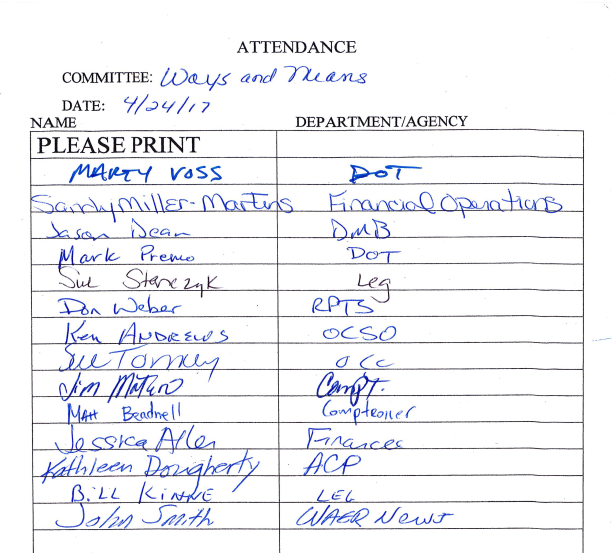
|




























































